|
Shareholders Take Emergency Action to Protect “Fracked” Family |
Shareholder activists usually play the long game, filing shareholder resolutions with companies, requesting dialogues with corporate managers, and issuing investor statements calling for industry-wide action. These efforts add up, over time, to spur social and environmental changes at corporations. But last December, an investor coalition led by Green Century Capital Management took rapid, emergency action to save one Pennsylvania family from having to drink water contaminated by natural gas fracking.
“Most of the filings and discussions with companies take place over at least six months, and sometimes it takes years to secure the changes you seek,” says Green Century president Leslie Samuelrich.
“But Green Century has started a rapid-response program to weigh in on important and timely issues.”
That program recently came to the aid of Tammy Manning and her family. The Mannings had moved to Franklin Forks, PA, a few years ago, just as energy companies were ramping up hydraulic fracturing operations in the Marcellus Shale region, an area stretching across Pennsylvania, New York, West Virginia, Ohio, and Maryland. When WPX Energy opened up two fracking wells near the Mannings’ property, Tammy noticed that something was very wrong in her household.
Her granddaughter Madison started waking up in the mornings vomiting, and this happened several times a week. Eventually, Manning pinpointed the family’s drinking water as a potential cause of the problem.
Natural gas fracking involves shooting thousands of gallons of chemical-laden water into rock formations deep in the ground to extract the natural gas contained below those formations. The process can result in fracking chemicals or methane—the main component in natural gas—leaking into drinking water tables. Fracking has negatively affected 161 wells across Pennsylvania, according to the nonprofit Environment America.
Manning called her township office, which directed her to WPX. WPX in turn called in the state Department of Environmental Protection to test the Mannings’ water.
“He came in, turned on the faucet in the kitchen,” Manning told Environment America. “He held a wand next to the faucet, and it started beeping and sounding off like crazy.”
The state investigator found toxic heavy metals and flammable methane in the Mannings’ water. It asked WPX to install a water tank on the Mannings’ property to replace the contaminated drinking water, and Madison’s health took a dramatic turn for the better shortly thereafter.
Late last year, however, WPX obtained a court order to seize the water tank on or after December 16th. While the Mannings thought WPX had given them the tank, a judge sided with WPXruling that the tank was on loan, and the company could take it back when it wished.
“To us, it seemed like petty vindictiveness and spiteful, beyond-the-pale behavior, the kind of corporate behavior where if the spotlight was shone on it, they would perhaps back away,” says John Rumpler, senior attorney at Environment America, which Manning contacted for help. “We thought direct pressure on the company could have an impact.”
So Environment America called on Green Century, with whom the organization had collaborated in the past.
“People like Tammy Manning are living on the front lines of fracking, and their kids are getting sick, their water’s getting contaminated, their air is getting polluted,” says Rumpler. “This wasn’t the kind of thing that could be addressed through political channels, so we thought that turning to our friends at Green Century, who regularly engage in shareholder activism, would be a natural way to address this.”
With only a matter of days in which to act, Green Century pulled together a group of investors to issue a shareholder response letter asking WPX to allow the Mannings to keep their water tank.
“Hydraulic fracturing operations are increasingly controversial, and WPX’s recent actions to remove clean drinking water from the Manning family have increased the reputational risk for the company and its shareholders,” the letter stated. “The company’s decision to remove the drinking water tank has resulted in negative media attention for the company and risks damaging the company’s community relations. ... We urge WPX to immediately drop its plans to remove the drinking water tank from the Mannings and make its change public.”
The pressure worked. Within less than a week, WPX agreed to continue to supply clean drinking water to the Mannings and other affected families in the area.
“We are monitoring the situation to do everything we can to make sure the Mannings have access to the water they need to drink, bathe, and cook for as long as they need it—it is the minimum that should be provided,” says Samuelrich.
This isn’t the only victory Green Century’s new rapid-response shareholder program has achieved. Last fall, it learned that Wilmar, the world’s largest palm oil trader, was considering joining forces with grocery giant Unilever to develop a sustainable palm oil supply chain. Conventional palm oil harvesters often raze large swaths of rainforest to grow palm oil crops.
“We had been tracking the issue and wanted to signal support from the investment community,” says Samuelrich.
So the company organized 40 institutional investors with over $270 billion in assets under management to call for “the development of transparent, traceable, deforestation-free palm oil supply chains.”
“In less than a month, Wilmar and Unilever announced their new policy, which is already having positive reverberations up and down the supply chain,” says Samuelrich.
For details on 2014 shareholder resolutions asking for corporate improvements around fracking and palm oil supply chains, see Green America’s 2014 Shareholder Resolution Focus List » |
|
General Mills Announces That Original Cheerios Are Now Non-GMO |
Consumers across the country took action with the GMO Inside Campaign to push General Mills to make Cheerios non-GMO.
General Mills' announcement of non-GMO Cheerios was huge news, since this was one of the first major consumer brands to go non-GMO based on public pressure, and paved the way for a growing number of non-GMO products.
(January 2014)
|
|
Debt Trap Payday Loans From Banks On The Way Out! |
Regions, US Bank, Fifth Third, and Wells Fargo agreed to phase out short term loans with interest rates up to 365%. These “deposit advance loans” commonly as “payday loans” trapped people in ongoing cycles of debt. Green America and our allies mobilized to halt these abusive loans.
|
|
Riding Wave of Success, GMO InsideAnnounces Campaign to Get GMOs Out of Honey Nut Cheerios |
No Letup in Pressure: New Consumer Campaign Builds Off Recent Victory In Getting General Mills To Remove GMOs From Original Cheerios
January 21, 2014
WASHINGTON, DC -- Green America’s GMO Inside campaign today launched a major push to get General Mills to drop genetically modified organisms (GMOs) from Honey Nut Cheerios--the company’s and the nation’s’ #1 breakfast cereal. The campaign’s website (http://gmoinside.org/cheerios/ ) and Facebook page (https://www.facebook.com/GmoInside) call on General Mills to remove GMOs from Honey Nut Cheerios and to use a third-party verifier to ensure that the cereal is, in fact, non-GMO.
On January 2, 2014, GMO Inside broke the news that its campaign to pressure General Mills had resulted in the major U.S. food producer to eliminate GMOs from original Cheerios. In a campaign relying heavily on social media to inform and involve consumers, the company was deluged with over 50,000 online postings to make original Cheerios GMO free. General Mills’ acknowledgment that it was dropping GMOs from original Cheerios created a firestorm of media attention and made millions more Americans aware of the GMOs that are common in the cereals that start their days.
Now, GMO Inside is urging General Mills to take the next logical step in relation to consumer demand and concerns. Over 6 million people – many of them children -- start their day with Honey Nut Cheerios. Honey Nut Cheerios contains a number of the same ingredients that are at-risk for GMOs as regular Cheerios, just with a higher concentration of sugar. Now that General Mills has completed a year-long process to remove GMOs from regular Cheerios, consumers will pressure the company to remove GMOs from their other cereals, starting with Honey Nut Cheerios. In addition consumers will continue to push General Mills needs to use third party verification to provide consumers with the assurance that its products are genuinely non-GMO.
Recently, Post Foods revealed to its customers that it is removing GMOs from its original Grape Nuts Cereal. Post is going one step further than General Mills by using third party verification to ensure Grape Nuts is non-GMO. Post has also stated to its customers that it is exploring removing GMOs from other products.
“General Mills has the opportunity to build on the important step they took in making regular Cheerios non-GMO by now taking the GMOs out of America’s favorite breakfast cereal, Honey Nut Cheerios,” stated Green America’s GMO Inside Campaign Director Nicole McCann. “More and more consumers are looking for non-GMO options, especially for the foods that they feed to their children, and those consumers will be letting General Mills know they want the GMOs off their breakfast table.”
“General Mills made the right move in removing GMOs from original Cheerios,” stated Green America President and GMO Inside Co-Chair Alisa Gravitz. “However, General Mills has sent confusing messages to its customers by saying that it was able to remove GMOs from original Cheerios because of their unique formula, but can’t remove them from other flavors of Cheerios. And the company denies that it made the change due to consumer demand, while claiming it listens to its customers. The truth is that General Mills responded correctly to enormous consumer pressure in removing GMOs from original Cheerios. Now consumers will put pressure on General Mills to remove GMOs from their other cereals, starting with Honey Nut Cheerios. And the reality is that the process General Mills put in place to remove GMOs from original Cheerios can be used with other varieties of Cheerios, starting with Honey Nut.”
Green America is the nation’s leading green economy organization. Founded in 1982, Green America (formerly Co-op America) provides the economic strategies, organizing power and practical tools for businesses, investors, and individuals to solve today’s social and environmental problems. http://www.greenamerica.org.
GMO Inside is a campaign dedicated to helping all Americans know which foods have GMOs inside, and the non-GMO verified and organic certified alternatives to genetically engineered foods. We believe that everyone has a right to know what’s in their food and to choose foods that are proven safe for themselves, their families, and the environment. GMO Inside gives people information and tools, and provides a place for a growing community of people from all walks of life, to share information and actions around genetically engineered foods. Join the campaign at www.gmoinside.org, and take part in the GMO Inside community on Facebook and Twitter.
MEDIA CONTACT: Will Harwood, (703) 276-3255 or wharwood@hastingsgroup.com.
|
|
Top 5 Unanswered Questions about Cheerios Removing GMOs! |
If you’re just hearing about General Mills removing GMOs from its original yellow box Cheerios, you might be wondering, “What does this announcement mean anyway?” Well, let’s start from the beginning.
In November 2012, GMO Inside called on consumers to tell General Mills to take the GMOs out of Cheerios. After a year of countless Facebook posts (over 50,000!), email actions, phone calls, media, and a video that went viral, General Mills complied. On January 2nd, GMO Inside discovered an article on the Cheerios website titled, “Cheerios and GMOs.” GMO Inside crafted a press release titled, “Victory for Consumers: General Mills Announces that Original Cheerios are Now Non-GMO” and blasted it out that day to the media and our lists. Throughout that week the story was picked up by every major news outlet and created quite the buzz on social media. We tracked over 250 news hits and collected thousands of comments on news articles, tweets, social media posts, and blogs.
We noted there were many unanswered questions, and some of the coverage failed to provide the factual information needed to understand the scope of the announcement. We’ve pulled together the top five questions and answered them here. Those questions that we couldn’t answer, we are calling on General Mills to clear up.
Q1. Will Cheerios get verified non-GMO from a third party such as the Non-GMO Project?
A. Currently, General Mills said it will put "Not Made with Genetically Modified Ingredients," on its boxes; however, that it is not an official certification. We suggest you call General Mills and tell them you’re not satisfied until Cheerios is verified!
Q2. Did Cheerios change their GMO source for vitamin E, or was this ingredient always non-GMO?
A. Cheerios has not responded to GMO Inside. We will continue to ask them about this ingredient (which tends to be sourced from GMO soy), and we encourage you to ask them too. Cheerios has indicated that corn and sugar ingredients will be sourced non-GMO.
Q3. Why not remove GMOs from all Cheerios products?
A. General Mills stated they will not remove GMOs from any of their other products. Additionally, they stated removing them from their other Cheerios products would be “impossible.” However, with an orderly transition, it is not impossible. There are other similar cereals on the market that are non-GMO, such as Cascadian Farm’s Honey Nut O’s (which is also organic!). Call General Mills’ customer service and ask them to remove GMOs from the rest of their products.
Q4. What’s the big deal about Cheerios removing GMOs anyway?
A. The big deal is that GMO Insiders targeted Cheerios for over a year to remove GMO ingredients from their yellow box product. Last year, General Mills CEO Kendall Powell said that “labeling GMO foods would require labeling virtually every product” in the grocery store. Yet, earlier this month, General Mills announced the removal of GMOs from Cheerios and claimed they “made investments in new systems at our production facilities to separate the ingredients we use to make original Cheerios from our other products.” They also claimed making this change to Cheerios “required significant investment over nearly a year.” The changes in the storing and processing facilities, as well as changes in sourcing non-GMO corn and sugar, are all important and commendable first steps for this company to take. However, General Mills needs to follow up on its commitment by becoming non-GMO verified by a third party, and then expanding non-GMO sourcing to additional products. Remind General Mills that you’re thankful they’ve started this process but you want verification.
Q5. Is General Mills removing GMOs from their original Cheerios yellow box product in Canada and Mexico too?
A. The announcement came from the US Cheerios website and no such announcement has been made on any other Cheerios websites outside of the US. If you would like to call and inquire about Canada or Mexico from inside the US, please call customer service here: 1-800-248-7310 between (7:30 a.m. - 5:30 p.m. CT, weekdays).
Canada: Contact customer service and ask if they are removing GMO ingredients from Canadian Cheerios: 1-800-767-5350 between (9:00 a.m. - 7:00 p.m. ET, weekdays). You can also send them a letter addressed to: General Mills Canada Corp, 5825 Explorer Drive, Mississauga, ON L4W 5P6
Mexico: In Mexico, Cheerios is sold under the Nestlé brand. You can find more information here. Teléfono de Nestlé España de atención al consumidor: 902 112 113
Got more questions? Ask us here in the comment section or call up General Mills today with your concerns.
Thank you, GMO Insiders, for taking action with us! Together we will take back our food supply!
|
|
Cheerios: Exploring Vitamin E |
Greetings, GMO Insiders, and nice to meet you! I am the new food campaigns director here at Green America, leading the GMO Inside campaign. 2014 is starting off great with the consumer victory to get Cheerios to go non-GMO for their original namesake cereal and I’m so happy to join the team. I’m looking forward to forging ahead alongside all of you to claim more victories this year.
For my inaugural blog post, let’s talk about Vitamin E (Tocopherol). Many of you may already know that it is often made from GMO crops, but for others this may be news, so let’s explore it a bit. What is Vitamin E? What does Vitamin E do?
Vitamin E is a nutrient that is found naturally in some foods, added to others, and available as a supplement. Its purpose? When added to foods it is predominantly used as a preservative to increase shelf life, by preventing the deterioration of fats. If Vitamin E is not found naturally in a food there are a couple of ways to produce it, including in a laboratory by chemical synthesis or by extracting from plants. The most common plants in the US used for GMO Vitamin E are soy, corn, and cottonseed. The majority of the supply of these crops in the US is GMO.
What foods are high in Vitamin E? The answer might surprise you. When we launched our campaign against Cheerios we pointed to the three ingredients we (consumers) wanted them to convert to non-GMO: sugar, cornstarch, and Vitamin E. In last week’s announcement that the original Cheerios would soon be hitting the shelves without GMOs, they only listed changes in sourcing of sugar and cornstarch. We need General Mills to clarify if their Vitamin E is or is not derived from GMO sources, like soy, corn, or cotton. Any commitment to non-GMO sourcing is incomplete without addressing all possible GMO ingredients.
So will you join us in asking General Mills if the vitamin E they use in Cheerios is non-GMO? Call General Mills at (800) 248–7310 and ask them to clarify. Additionally, take action with us by sending the CEO a note thanking him for removing GMOs from Cheerios and asking General Mills to get third-party verified.
|
|
Victory: "Original" Cheerios to Go GMO-Free |
Great news for our work together for a sustainable food system!
Just a few days into the new year, we have our first victory of 2014 to celebrate.
After a year of pressure from you and other Green Americans, General Mills announced on its corporate Web site that its "original" Cheerios are now produced without genetically modified ingredients. General Mills announced that the company was "able to change how we source and handle ingredients to ensure that the corn starch for original Cheerios comes only from non-GMO corn and our sugar is only non-GMO pure cane sugar."
This announcement comes after tens of thousands of you called, e-mailed, and posted on Cheerios Facebook page demanding non-GMO options for the US market.
One year ago, in November 2012, Green America's GMO Inside campaign starting organizing consumers to put pressure on General Mills to make Cheerios without GMOs. Cheerios are a top-selling cereal in the U.S. and often one of the first solid foods fed to children. As soon as the campaign launched, tens of thousands of consumers started flooding Cheerios’ Facebook page with concerned comments regarding GMOs in Cheerios, and used an app put out by Cheerios to spell out anti-GMO messages in the Cheerios font. In October 2013, Green America issued a real corporate responsibility report for General Mills, and called on consumers to email and call the General Mills to get GMOs out of Cheerios. Our GMO Inside campaign also put out a video highlighting the GMOs in Cheerios that was watched by over 200,000 viewers. Over 25,000 people took part in the email actions and calls to the company. In the last week of 2013, callers to the company were told that Cheerios would have a big announcement about GMOs soon.
“Removing GMOs from original Cheerios is an important victory in getting GMOs out of our food supply and an important first step for General Mills," says Todd Larsen, Green America's Corporate Responsibility Director. "Original Cheerios in its famous yellow box will now be non-GMO and this victory sends a message to all food companies that consumers are increasingly looking for non-GMO products and companies need to meet that demand.”
This is a great victory for the non-GMO movement, as a major manufacturer of a top breakfast cereal proves that it is possible to shift a supply chain to non-GMO ingredients in response to consumer demand.
Throughout 2014, Green America's GMO Inside campaign will push for more food brands to follow General Mills' lead, and we'll push for General Mills to shift the rest of its cereal, and other products, to non-GMO sourcing. We'll also push to make sure that all companies who remove GMOs from their food, provide supply chain transparency and verification.
For now, only "original" Cheerios in the iconic yellow box have been announced as GMO-free. General Mills continues to manufacture 11 other varieties of Cheerios. Please take a moment today to thank General Mills for its first step toward non-GMO breakfast cereals. General Mills listened to YOU. Please let them know you appreciate it.
|
|
Cheerios join Non GMO Foods |
GMO Insiders,
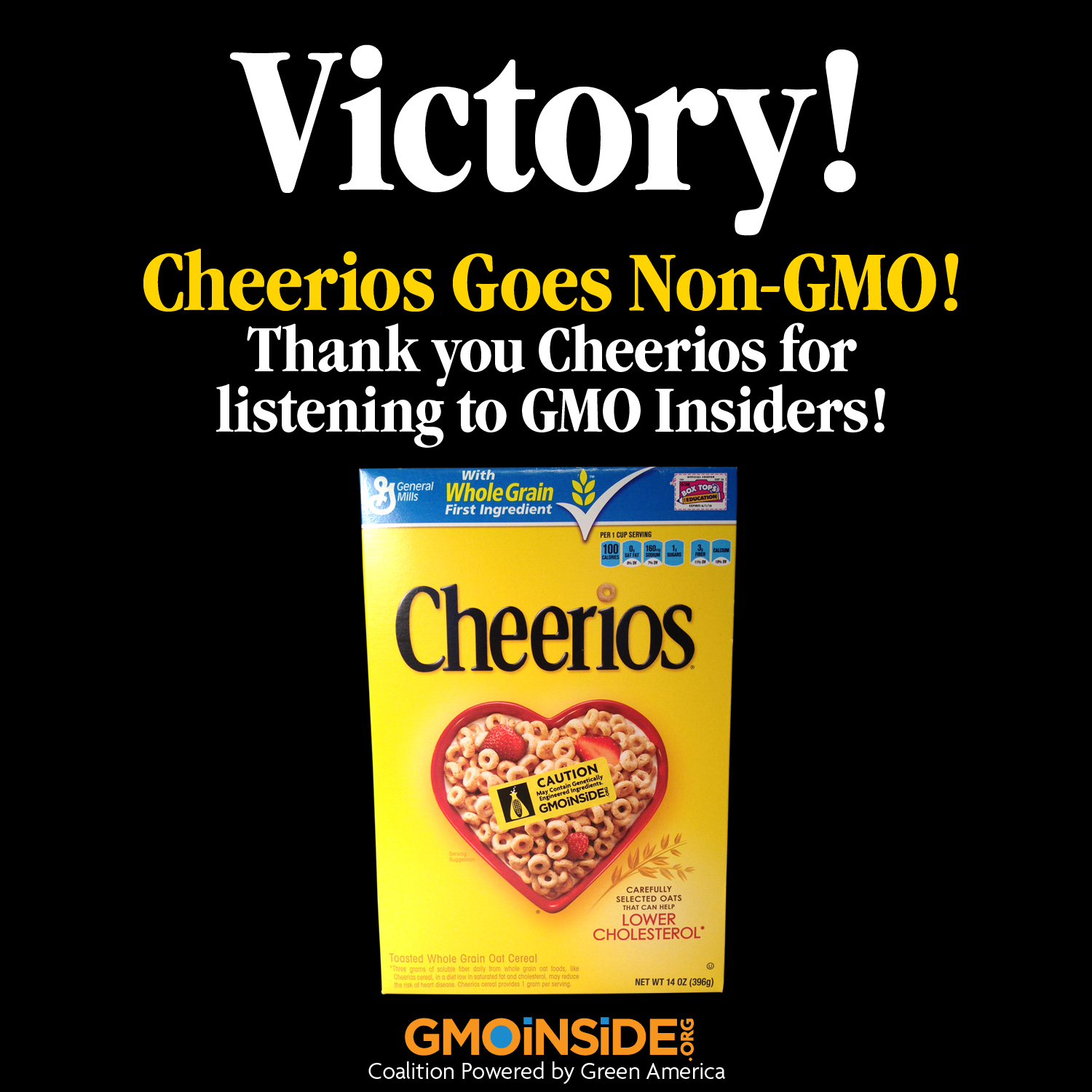
There's big news to share. Cheerios are now Non GMO. On a new page launched over the holiday, General Mills announced that they no longer use genetically modified ingredients in original Cheerios.
"It’s the unique and simple nature of original Cheerios that made this possible – and even that required significant investment over nearly a year. Cheerios’ principal ingredient has always been whole grain oats, and there are no GMO oats. We use just a small amount of corn starch in cooking, and just one gram of sugar per serving for taste. So we were able to change how we source and handle ingredients to ensure that the corn starch for original Cheerios comes only from non-GMO corn, and our sugar is only non-GMO pure cane sugar. "
It's no coincidence that General Mills began investing in non-GMO Cheerios when it did.
When GMO Inside began in November 2012, we chose General Mills as our first target for using genetically modified ingredients in Cheerios. It all started when General Mills launched a customer feedback Facebook app, only to be flooded with comments from GMO Insiders, causing the whole project to shut down.
Throughout the year, GMO Insiders continued to ramp up consumer pressure on the beloved Cheerios brand, signing over 37,000 petitions to General Mills' CEO Ken Powell. Green America Executive Director Larry Giammo and Campaigns Director Liz O'Connell went the extra mile to deliver petitions to General Mills executives face-to-face. Liz went on to attend the General Mills stakeholder meeting at GM headquarters, presenting on behalf of consumers to explain our concerns.
In October 2013, GMO Inside took to the media and held a virtual press conference to release the GMO Inside report on General Mills' real corporate social responsibility, garnering 17 media stories. The GMO Inside Cheerios video soon gained over 200,000 views on YouTube. Meanwhile, GMO Insiders continued to take action with the GMO Inside Send Back Attack, mailing "Satisfaction Guaranteed" Cheerios labels to General Mills' headquarters along with handwritten letters demanding a better product.
And just before the holidays, GMO Insiders calling into General Mills' phone lines were told to expect a big announcement from the brand, inspiring our team to turn up the heat on Cheerios through the end of the year.
All thanks to you.
But the fight isn't over. This new development only applies to original Cheerios in the iconic yellow box. Other Cheerios cereals such as Honey Nut and Multi-Grain still contain genetically modified ingredients.
"For our other cereals, the widespread use of GM seed in crops such as corn, soy, or beet sugar would make reliably moving to non-GM ingredients difficult, if not impossible. "
Non-GMO, yellow box original Cheerios is just one step, but it's a big one. Stay tuned over the next few days so you can join us in thanking General Mills, and to ask for continued progress with all of their cereals.
Congratulations, GMO Insiders! You made this victory possible.
Click here to read the official press release.
|
|
Victory for Consumers: General Mills Announces That Original Cheerios Are Now Non-GMO |
Consumers across the country took action with the GMO Inside Campaign to push General Mills to make Cheerios non-GMO
January 2, 2014
WASHINGTON, DC -- With 40,000 Facebook posts from consumers who took part in GMO Inside’s campaign calling on General Mills to make Cheerios non-GMO (http://gmoinside.org/cheerios/), General Mills today posted its statement on GMOs http://cheerios.com/en/Articles/cheerios-and-gmos. The company states: “It’s the unique and simple nature of original Cheerios that made this possible – and even that required significant investment over nearly a year,” and “we were able to change how we source and handle ingredients to ensure that the corn starch for original Cheerios comes only from non-GMO corn, and our sugar is only non-GMO pure cane sugar.”
One year ago, in November 2012, GMO Inside starting calling on consumers to put pressure on General Mills to make Cheerios without GMOs due to concerns over the health and environmental impacts of GMOs. Cheerios are a top-selling cereal in the U.S. and often one of the first solid foods fed to children. As soon as the campaign launched, tens of thousands of consumers started flooding Cheerios’ Facebook page with concerned comments regarding GMOs in Cheerios (http://gmoinside.org/launch-gmo-inside-campaign-cheerios/), and used an app put out by Cheerios to spell out anti-GMO messages in the Cheerios font (http://gmoinside.org/cheerios-facebook-page-bombarded-by-anti-gmo-activists/). In October 2013, GMO Inside issued a real corporate responsibility report for General Mills (http://gmoinside.org/cheerios/), and called on consumers to email and call the General Mills to get GMOs out of Cheerios. GMO Inside also put out a video highlighting the GMOs in Cheerios (http://www.youtube.com/watch?v=KbiDgOkhoyY&feature=youtu.be) that was watched by over 200,000 viewers. Over 25,000 people took part in the email actions and calls to the company. In the past week callers to the company were told that Cheerios would have a big announcement about GMOs soon.
Green America Corporate Responsibility Director Todd Larsen stated: “Removing GMOs from original Cheerios is an important victory in getting GMOs out of our food supply and an important first step for General Mills. Original Cheerios in its famous yellow box will now be non-GMO and this victory sends a message to all food companies that consumers are increasingly looking for non-GMO products and companies need to meet that demand.”
John W Roulac, GMO Inside co-founder and co-chair stated: "This is a huge victory for the non-GMO movement. I want to thank all the GMO Insiders for using social media to convince America’s largest packed food brand to go non-GMO with a major product. History is being made today and more food brands will rush towards non-GMO foods. "
GMO Inside, a campaign of national non-profit organization Green America, welcomed the news that General Mills is now producing original Cheerios without GMOs, and is encouraging consumers to let General Mills know that now is the time to make all Cheerios non-GMO. In addition to original Cheerios, General Mills manufactures 11 other varieties of Cheerios for sale in the U.S., including highly popular Honey Nut Cheerios, and the other 11 varieties continue to include GMOs. General Mills admits on its website that all Cheerios cereals sold in Europe are made without GMOs, and increasingly, U.S. consumers will be calling on General Mills to make all its cereals non-GMO in the U.S. as well.
Green America is the nation’s leading green economy organization. Founded in 1982, Green America (formerly Co-op America) provides the economic strategies, organizing power and practical tools for businesses, investors, and individuals to solve today’s social and environmental problems. http://www.greenamerica.org.
MEDIA CONTACT: Will Harwood (703) 276-3255 or wharwood@hastingsgroup.com
|
|
Winter 2013 |
|
|
What is the Best Butter for People and Planet? Land O' Lakes has Room to Improve |
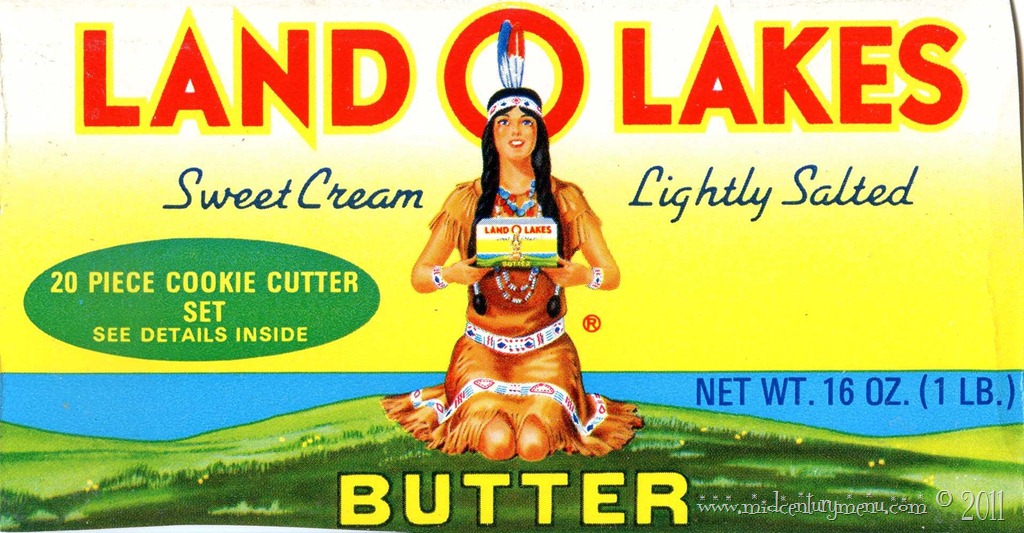
Land O'Lakes: A household name for the dairy-inclined, and an iconic American brand with a proud legacy as a farmer cooperative. But is it the best butter out there?
Founded in 1921, Land O'Lakes is now the nation's second largest member-owned co-op. Made up of almost 4,000 producer members, the co-op is made up of six different types of enterprises: dairy foods, animal feed, crop seed, business development services, and transport and licensing.
Taking a closer look at Land O'Lakes crop seed enterprise, you'll find that Land O'Lakes owns Forage Genetics, the co-developer of genetically engineered alfalfa (Monsanto was the other developer). The USDA approved GMO alfalfa for deregulation and commercial use in January 2011.
If you go one step further and look into Land O'Lakes management team, you'll find that their vice presidents, supply chain management experts, and operations officers are linked to companies such as General Mills, Pepsi, and Mobil Oil. Additionally, some of Land O'Lakes products are licensed by Dean Foods, the largest producer and distributor of dairy in the U.S.
From their website: "Land O’Lakes, Inc. will continue to advocate for the continued safe and effective use of agricultural biotechnology to increase the food supply while lowering cost. And we will continue to engage in an informative dialogue with our consumers so that they understand the safety, prevalence and benefits of GM technology and can make informed choices for themselves and their families."
Keep in mind, Land O'Lakes contributed nearly $100,000 to defeat I-522 in Washington state.
By playing a direct role in developing GMO alfalfa for commercial use, spending hundreds of thousands of dollars to block labeling, and denying the facts about genetically modified crops and their impact on humans and the environment, Land O'Lakes contradicts its self-proclaimed dedication to helping consumers make informed choices. Especially considering that Land O'Lakes has built its reputation on being a member-owned cooperative, we think Land O'Lakes can do better.
For your winter holidays this year, opt for non-GMO verified or USDA organic butters to ensure that your holiday cookies are just like Grandma used to make. Stay tuned this month for some of our favorite holiday cookie recipes.
Think Land O'Lakes can do better than GMO butter? Take action now and demand better butter. Click here to get GMOs out of dairy!
|
|
I can't believe it's in butter! |
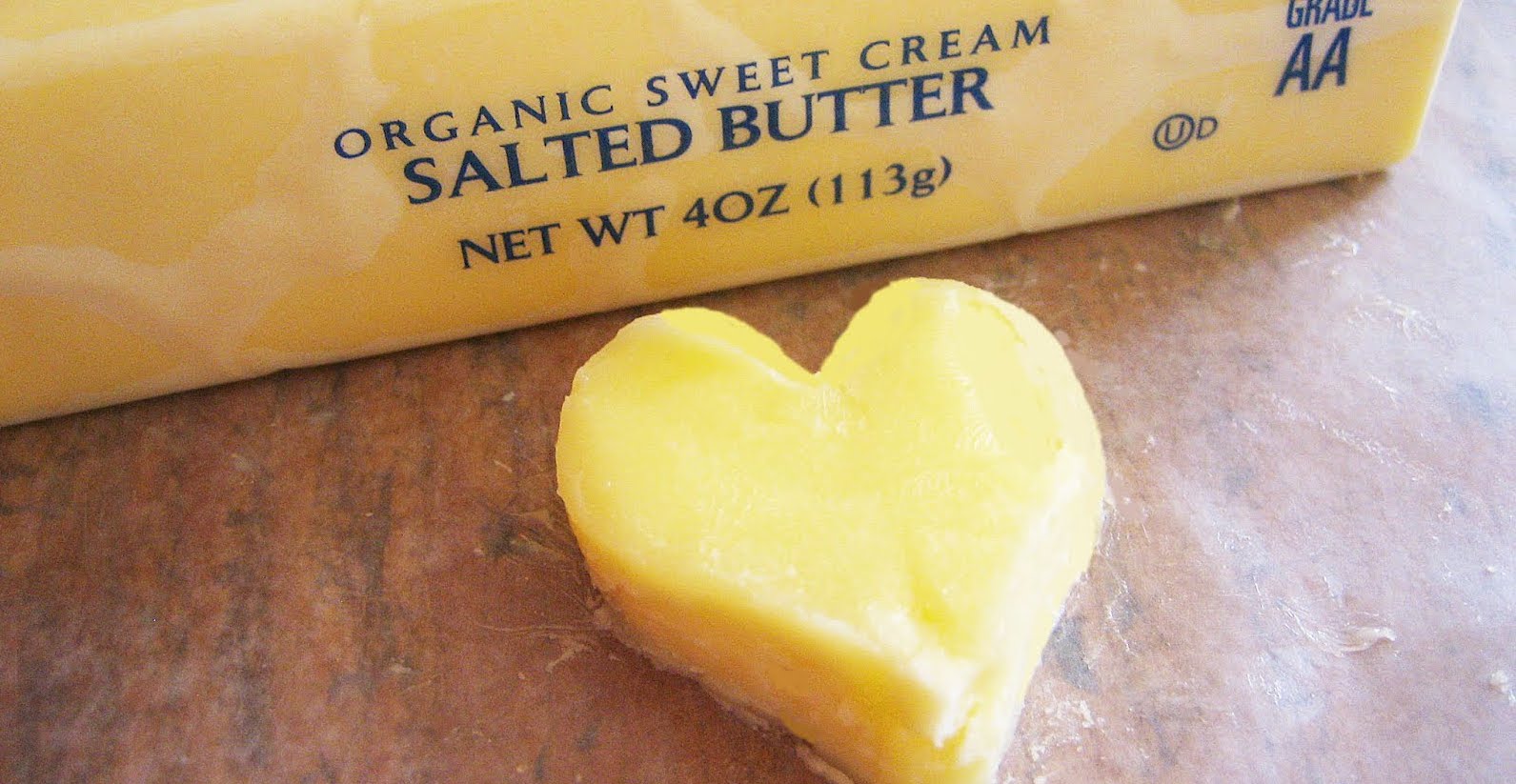
BUTTER. A key ingredient in so many delicious things. If your diet includes dairy, you're probably a big fan.
If you are a butter-lover -- or if you've ever visited the refrigerated section of any grocery store -- you have probably noticed the "farm-fresh" and "all-natural" marketing tactics of mass-produced dairy. Whether it's a smiling cow, a scenic green pasture, or an American Indian (ahem, Land O'Lakes), dairy companies work hard to make their butters seem like they're straight from the good ol' fashioned churn.
However, very little of the industrialized dairy industry is reflected in those carefully marketed images. Most dairy cattle suffer day after day in concentrated animal feeding operations, also known as CAFOs. In addition to demonstrating the horrifically inhumane treatment of animals in industrialized agriculture, CAFOs are also a huge source of land and water pollution.
But here's where the GMOs come in: Most non-organic dairy operations raise their cattle on genetically modified animal feed.
Take Dean Foods, for example. Although you might not recognize the name, Dean Foods is one of the largest dairy corporations in the U.S. and owns brands including Garelick Farms, Alta Dena, and Land O'Lakes. Dean Foods is also a leader in promoting GMOs.
From the Dean Foods' website: "We support efforts to educate the public about the safety, prevalence and benefits of GMOs." Dean Foods also claims that their milk does not contain GMOs, though they raise their cattle on genetically modified animal feed. Another fun corporate food fact: Land O'Lakes co-developed genetically engineered alfalfa, directly contributing to the GMO animal feed supply. Unsurprisingly, Land O'Lakes contributed nearly $100,000 to the No on I-522 lobby.
Don’t get us wrong - we love butter. But there are Bad Butters, and there are Better Butters. Bad Butters try to disguise their industrialized agricultural practices with pictures of happy cows. Better Butters stick to their mission of providing sustainable, high-quality products.
So, before your next trip the grocery, please consider supporting Better Butters! Suggested brands include Kerrygold or Organic Valley. Remember, if it’s not USDA certified organic or verified by the Non GMO Project, it’s probably GMO.
|
|
Main Street Launch |
|
|
Nuestra Comunidad Development Corporation |
|
|
Northwest Side Community Development Corporation |
|
|
Northwest Ohio Development Agency |
|
|
United Bank of Philadelphia |
|
|
OneUnited Bank |
|
|
Fall 2013 |
|
|
Want Non-GMO Cheerios? Just Fly to Europe |
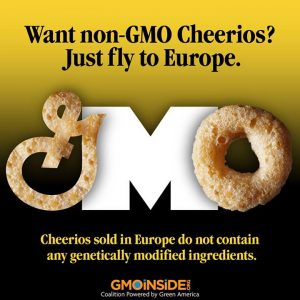
Hey GMO Insiders,
First off, thank you! The feedback we've gotten so far after our report release last week has been great, and we know we're lucky to have thoughtful and engaging activists following our work. On that note, we've received a lot of questions about Cheerios in Europe, and thought it'd be good to clarify our point on this one.
Cheerios sold in Europe do not contain any genetically modified ingredients. General Mills addresses this briefly in their Global Responsibility Report for 2013: "As a consumer-focused company, GM tries to deliver what consumers what and need. For that reason, products we produce for Europe do not use genetically modified ingredients."
(Quick note: In Europe, General Mills operates under a joint "cereal partnership"venture with Nestle, which is why European Cheerios display the Nestle logo. However, General Mills still profits from all their products sold under Nestle's name in Europe.)
Since 1997, the EU has required mandatory labeling of all genetically modified foods. Regulations were updated in 2000 and 2003, reinforcing a rigorous safety assessment on a case-by-case basis for any GMO foods. Due to this use of the precautionary principle, many growers and consumers in European markets are careful to check labels for genetically modified ingredients.
With the lack of consumer approval (or even demand) for foods containing GMOs in Europe, General Mills provides accordingly - with Cheerios that do not contain GMOs. Unfortunately, the same does not apply here in the U.S.
As part of our GMO Inside campaign, we believe that General Mills should offer the same, non-GMO Cheerios that they already produce for consumers in the EU to consumers outside of the EU (that's us!). Until then, if you want to be sure your Cheerios are free of GMOs, all you have to do is book an $800 round trip flight to Europe and stock up.
If $800 is too steep, take action now by signing our petition at NoGMOsCheerios.org and sending our new YouTube video to 10 friends.
Until next time,
Michelle
|
|
Meet the World’s 1st Non-GMO Project Verified Gum, Glee Gum |
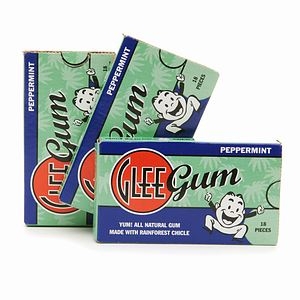
Verve, Inc. announced its full line of Glee Gum as the world’s first Non-GMO Project Verified chewing gum.
Verve, Inc., maker of Glee Gum, is an independent, certified woman-owned business, dedicated to creating environmentally and socially responsible products.
GMOs, or "genetically modified organisms,” are plants or animals that have been genetically engineered with DNA from bacteria, viruses, and other animals and plants. These experimental combinations of genes cannot occur in nature and have not been proven safe. Learn more about the dangers of GMOs and how you can fight them at Green America’s GMO Inside Campaign.
Non-GMO Project Verification signifies that all flavors of Glee Gum have been produced in compliance with the Non-GMO Project Standard—following rigorous best practices for GMO avoidance, including segregation and traceability to prevent contamination.
“We believe in consumers’ right to know when GMOs are in their food,” Verve president and founder Deborah Schimberg explains. “And we hope that the US will join the 60-plus other countries around the world that require labeling. In the meantime, it was important to our company and our customers to seek Non-GMO Project Verification. We’re thrilled to receive it, and consider it another great reason to feel good about chewing Glee Gum.”
Since October 2011, Glee Gum has been a proud partner of the Just Label It! campaign, calling for the mandatory labeling of genetically engineered food.
Glee Gum contains no artificial flavors, colors, sweeteners, or preservatives, and does contain some Fair Trade ingredients. It’s the only gum in North America made with chicle, a tree sap harvested sustainably to help conserve the rainforest.
|
|
Gap and Old Navy Make Toddler “Jeggings” Through Sweatshop Labor |
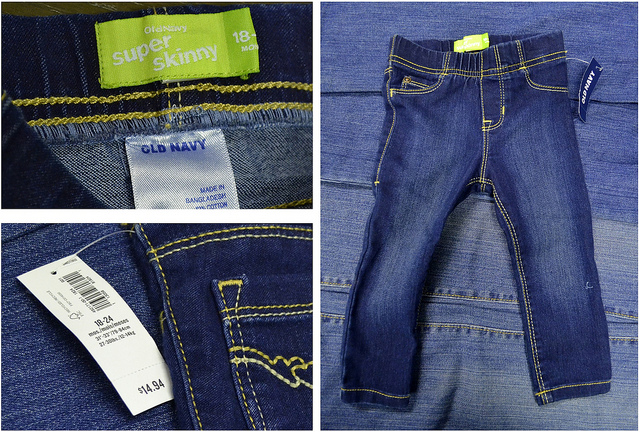
Gap and Old Navy claim their “corporate monitors” audit working conditions. So how'd they miss 3,750 workers in Bangladesh clocking in over 100 hours a week at poverty level wages?
Gap and Old Navy claim they’ve deployed “corporate monitors” to audit working conditions. So how did those monitors miss out on 3,750 workers performing sweatshop labor in Bangladesh routinely working over 100 hours a week at less than subsistence income?
The Institute of Global Labour Rights released a report that contradicts Gap and Old Navy’s claims to policing their supply chains. They investigated the Next Collections “Factory”---rightfully called a sweatshop.
Located on the outskirts of Dhaka, the factory is part of the Ha-Meem group, Bangladesh’s second largest garment exporter which owns 26 factories and employs over 30,000 workers. Approximately 70 of production at Next Collections is for Gap and Old Navy.
The report unveiled that:
- Next Collections workers are forced to toil 14- to 17-plus-hour shifts, seven days a week, routinely putting in workweeks of over 100 hours. Workers are visibly sick and exhausted from the grueling and excessive hours.
- Workers are paid in cash, off the books and cheated of 15 percent of their grueling overtime hours. Management hands out phony pay slips to pretend that Gap is in compliance with legal hours and wages.
- Workers live in miserable poverty in tiny primitive hovels, and earn just 20 to 24 cents per hour. By the third week in a month, most have no money left for food.
- Physical punishment and illegal firings are the norm. Pregnant women are illegally terminated and denied their legal paid maternity leave.
 All of this to produce clothes like Old Navy’s “Super Skinny Pull-on Jeggings For Baby,” skintight pants for toddler girls sold in the U.S. for $14.94 (pictured). All of this to produce clothes like Old Navy’s “Super Skinny Pull-on Jeggings For Baby,” skintight pants for toddler girls sold in the U.S. for $14.94 (pictured).
What can you do to stand up against sweatshop labor, save lives, and prevent another Rana Plaza tragedy?
- Learn more: Read the report and learn more about abuses by Gap and Old Navy. Plus learn about the United Nations Women’s Empowerment Principles from Pax World in Women, Garment Work and Safety: Clothes to Die For?
- Take action with Green America: Tell leading clothing companies to protect sweatshop workers’ lives and end labor abuses »
- Get more resources: Read Green America’s resources about what you can do about sweatshop labor.
|
|
Credible Green Marketing Claims: Guide to FTC Green Guides |
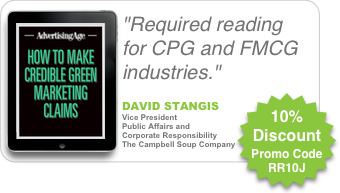
This new expert report will help businesses understand what they need to know about the new FTC Green Guides, the standards to avoid “greenwashing” marketing claims.
A new report from marketing experts Jacquelyn Ottman and David Mallen will help businesses understand what they need to know about the new FTC Green Guides, the standards to avoid “greenwashing” marketing claims.
AdAge is releasing the new report, “How to Make Credible Green Marketing Claims: What Marketers Need to Know about the Updated FTC Green Guides,” co-authored by Jacquelyn Ottman of J. Ottman Consulting and David Mallen from the National Advertising Division of the Better Business Bureau.
Save 10% off the new guide with promo code RR10J.
Jacquelyn Ottman, a green marketing guru and author of The New Rules of Green Marketing, is a Green Festival speaker and webinar presenter who has shared her marketing expertise with small green businesses across the country.
About The FTC Green Guides on Environmental Marketing
For readers not familiar with it, the FTC published the first edition of the Green Guides in 1992. Their goal: to help advertisers avoid deceptive or misleading environmental marketing claims. These Guides are the go-to standards for green marketing claims.
The FTC Green Guides have been updated from time to time as the green marketing landscape evolved. This latest update addresses such new terms that have entered the lexicon as ‘carbon offsets’ and ‘renewable materials’. It spotlights the use of corporate and product-related eco-seals and certifications. Most importantly, it all but eliminates the use of terms, images, and other attempts to communicate generalized environmental claims such as ‘green’, ‘environmentally friendly’ and ‘eco-friendly.”
The new report provides:

- an overview of the FTC Green Guides and how they can help businesses reduce risks of greenwash and overcome consumer ‘green fatigue’;
- a detailed discussion of what’s new to the FTC Green Guides since they were last updated in 1998 (in a word, a lot!);
- several case studies from the NAD, FTC and other bodies of well-known brands whose claims have been called into question with lessons learned;
- the 43-item “Ottman Checklist for Credible Green Marketing” – its first time in print. It guides businesses step-by-step through a process for ensuring they stay in check with the Guides;
- 5 alternative strategies for underscoring credibility — including a discussion as to why cause marketing may be dead;
- seven charts and graphs of hot-off-the-press data on consumer attitudes towards green claims, eco-labels, etc., which are also provided as a free PowerPoint;
- the complete text 2012 FTC Green Guides as well as a variety of helpful links.
Co-Authors:
Jacquelyn A. Ottman is the founding chair of J. Ottman Consulting, one of the first green marketing consultants. Over the past 24 years, her pioneering green marketing consultancy has flourished, working for over 60 Fortune 500 companies and several eco-labels. She has written four award-winning books on green marketing and eco-innovation. She is a respected sustainability leader having chaired juries for the Edison Awards and the Effie Awards and is also the founding co-chair of the Sustainable Business Committee of the Columbia Business School Alumni Club of New York. She is a frequent contributor to The Huffington Post, TriplePundit, and several other websites.
David G. Mallen is the current Deputy Director for Legal Affairs at the National Advertising Division of the Better Business Bureau, having worked there since 1999. He is an established leader in claim substantiation issues and has resolved disputes between food and drug products, telecommunication services, and computer technology. He is an experienced trial lawyer and formerly practiced law at Kensington & Ressler L.L.C, where he concentrated on product liability defense, business counseling, and commercial litigation.
|
|
Coca-Cola and World Wildlife Fund Announce New Global Environmental Goals and Partnership |

The Coca-Cola Company and World Wildlife Fund (WWF) are working to advance the Coca-Cola system’s sustainability stewardship with new global environmental goals and an expanded global partnership.
The goals focus on sustainable management of water, energy and packaging use as well as sustainable sourcing of agricultural ingredients through 2020.
Coca-Cola and WWF jointly developed new 2020 environmental sustainability goals and performance targets for the Coca-Cola system, including nearly 300 bottling partners in more than 200 countries. These goals include :
- Improve water efficiency by 25%.
- Help ensure healthy, resilient freshwater systems.
- Reduce CO2 emissions embedded in ‘the drink in your hand’ by 25%.
- Responsibly source material for PlantBottle packaging.
- Sustainably source key agricultural ingredients.
In addition to the goals jointly developed and announced with WWF, Coca-Cola has reaffirmed its water replenishment goal and evolved its package recovery goal through 2020 to include :
- Replenish 100% of water used.
- Reach a 75% recovery rate of bottles and cans in developed markets.
Since 2007, Coca-Cola and WWF have worked together to conserve and protect freshwater resources around the world while helping to improve the efficiency of Coca-Cola’s global operations.
To date, the partnership has led to major conservation gains, including helping to improve the ecological health of seven of the world’s most important freshwater basins across five continents, helping improve the Coca-Cola system’s water efficiency by 20 percent, working to prevent 5 million metric tons of CO2 emissions across Coca-Cola’s global manufacturing operations, and promoting more sustainable agricultural practices in the Company’s supply chain.
WWF is the world’s leading conservation organization, working in 100 countries for half a century. With the support of almost 5 million members worldwide, WWF is dedicated to delivering science-based solutions to preserve the diversity and abundance of life on Earth, halt the degradation of the environment and combat climate change.
|
|
Avoiding GMO Foods? Chobani Yogurt's Uses GMO Milk |
Originally published by The Alternative Daily
August 23, 2013
Source article
GMO Inside, a coalition against the use of genetically modified ingredients, is putting pressure on Chobani, Inc. to stop using GMO milk in their yogurt and other products.
The seven member coalition includes GMO Free USA, Label GMOs, Green America, Nutiva, Food Babe, Food Democracy Now! and Institute for Responsible Technology.
GMO Inside has started their national campaign against Chobani, Inc. because most of their milk comes from industrial New York dairy farms. According to campaign director Elizabeth O’Connell, “cows living on industrial farms eat GMO feed.”
Chobani is the leading brand of Greek yogurt in the United States, and many people see Greek yogurt as a healthy snack food or addition to their meals. The health properties of GMO ingredients, however, are shady at best.
Chobani yogurt labels indicate that only natural ingredients are used, and that the milk comes from cows that were not treated with rBST growth hormone. The GMO Inside coalition, however, wants more. They are asking Chobani to stop marketing their products as “natural” and “real” when they they are in fact a part of the GMO Food Family.
O’Connell says, “Chobani has an opportunity to be a leader amongst meat and dairy companies by listening to its customers and ensuring its cows are given non-GMO food.”
Lindsey Kos, Chobani communications manager, has responded, “our team is dedicated to addressing GMOs and is currently navigating its complexities, specific to dairy. As it stands now, we do not claim to be GMO-free… according to some, doing so would require us to ensure the feed to more than 78,000 cows across more than 875 farms is 100 percent GMO-free. It requires teamwork among our employees, farmers and industry partners.”
GMO Inside is inviting all concerned consumers to sign a petition requesting that Chobani use milk from non-GMO-fed cows.
|
|
Chobani Greek Yogurt: a GMO Food that is "Naturally" Healthy? |
Originally published Before It's News
August 28, 2013
Founded in 2005 by Turkish immigrant Hamdi Ulukaya, Chobani finally launched in 2007 to critical acclaim. The company now commands the top spot in the booming $2 billion a year Greek yogurt category–boasting more than 70 products, and a team of more than two thousand employees around the world.
The Good
Greek yogurt is higher in protein than regular yogurt—about twice as much—and Chobani positions this protein source as an excellent workout food. The company also claims its ingredients are “all natural,” and while not organic, Chobani also says none of the dairy used comes from cows fed rBST—the controversial growth hormone common in conventional dairy. But while they claim not to use rBST, the Chobani website also states “According to the FDA, no significant difference has been shown, and no test can now distinguish, between milk from rBST treated cows and untreated cows.”
Chobani products avoid the use of artificial sweeteners. “The sugars found in our products come from milk (lactose), real fruit (fructose), honey and evaporated cane juice (which is less processed than white table sugar and is used to sweeten the fruit, vanilla and chocolate chunk preps used in our authentic strained Greek yogurt products).”
The Shepherd’s Gift Foundation is Chobani’s charitable arm, giving ten percent of all profits to nearly twenty organizations including the Making Waves to Fight Cancer organization, Earthquake relief efforts in Erds, Turkey, Luke’s Wings and Chenango Memorial Hospital.
The Bad
GMO Inside, the nonprofit organization working to bring attention to genetically modified ingredients in food, recently targeted Chobani for the use of the word “natural,” which is featured prominently on all of its product packaging, website and marketing materials. It’s even earned the conventional yogurt brand a spot in most Whole Foods markets, the retail chain that recently announced it would introduce GMO labeling in its stores by 2018.
While the company does not use milk from dairy cows fed artificial growth hormones, it also does not source organic milk, GMO Inside points out. Conventional dairy cows are most often fed genetically modified alfalfa, corn and soy. The World Health Organization defines GMOs as not occurring naturally. Several leading food producers have faced class action lawsuits over use of the term “natural” on foods that contained GMOs. As a result of the GMO Inside campaign, thousands of customers have petitioned Chobani to switch to organic dairy. But instead of changing its ingredients to those that are truly natural, it appears the company is simply changing its marketing strategy, opting to use the word “real” instead of “natural”, which has recently been added to the Chobani website. Presumably new packaging will also replace “natural” with “real” in the very near future.
The other major issue that’s giving Chobani a bad name is the manufacturing process. One ounce of the Greek yogurt requires three to four ounces of fresh milk, which produces a very acidic whey by-product once processed. According to an expose in Modern Farmer, “it’s a thin, runny waste product that can’t simply be dumped. Not only would that be illegal, but whey decomposition is toxic to the natural environment, robbing oxygen from streams and rivers. That could turn a waterway into what one expert calls a “dead sea,” destroying aquatic life over potentially large areas. Spills of cheese whey, a cousin of Greek yogurt whey, have killed tens of thousands of fish around the country in recent years.”
The Questionable
The large quantities in acid whey are such a huge problem for Chobani that they’re paying farmers to take it off their hands, but there may be another option. Dave Barbano, a dairy scientist at Cornell thinks the protein in acid whey may find a use in infant formula.
While that might very well do away with some of the whey waste, it is essentially offering newborns a concentrated genetically modified food, and GMOs have been linked to a number of serious health issues. Newborns and infants have particularly sensitive digestive systems, which may not be the healthiest use for genetically modified whey.
Recently, the USDA invited Chobani to supply pilot schools with its Greek yogurt as part of efforts to provide school children healthier meals. If successful, the plan is to roll out the Greek yogurt offering to all of the U.S. school systems.
A higher protein food, Greek yogurt may be a step up from the Pink Slime U.S. schools were serving recently. But a six-ounce serving of fruit flavored Chobani can contain as much as 20 grams of sugar (five teaspoons). The recommendation for children is no more than three teaspoons of sugar per day. Granted, some of the sugars in Chobani yogurts are naturally occurring from fruit and the dairy, but cane sugar is the third ingredient listed on its popular blueberry flavor.
|
|
Summer 2013 |
|
|
Away with the Whey: Chobani Greek Yogurt Puts Rural Idaho in a Stink |
Originally Published by Boise Weekly
By: Carissa Wolf
August 14, 2013
Source Article

The problem of what to do with the company's acid whey biproduct is causing headaches for neighbors
Mike and Deb Courtnay can count miles between their neighbors' homes east of Hollister, where nameless, numbered roads stretch straight and remain off the GPS grid. On some days the only sighting of life near the Courtnays' Southern Idaho farmstead comes in the form of deer that wander down the South Hills toward fields of wheat and alfalfa. For five generations, the Courtnay family relished the peace and quiet in what Deb calls the "suburbs" of Hollister.
Then, Chobani moved in.
"Suddenly, we had trucks going day and night," Deb said of the usually desolate sage- and scrub-lined roads, which last spring were filled with tanker trucks on the half-hour trek southwest from the Twin Falls Chobani plant to the outskirts of Hollister.
The trucks hauled the Greek yogurt industry's biggest quandary and a smelly secret: gallons and gallons of acid whey-spiked wash water.
Protein-hungry Americans' love affair with the thick, velvety variety of yogurt brought economic promise to the Twin Falls area last year with the opening of a Chobani processing plant—the largest yogurt factory in the world. According to CNN Money, Chobani revenue went from zero to $1 billion in five years, a growth rate on par with Facebook and Google.
The company also recently received a boost from the U.S. Department of Agriculture's approval of Greek yogurt as a school lunch menu item and Washington, D.C., lobbying efforts that made Chobani a top supplier.
Along with the economic impact that comes with the roughly 1,000 full- and part-time workers Chobani now employs in the area came hundreds of thousands of gallons of acid whey—a manufacturing byproduct of Greek yogurt—to Hollister-area farmland.
The byproduct of this blooming love affair hasn't found the same embrace consumers and politicians extend to the finished product. Chobani reported record earnings while neighbors near its upstate New York plant complained of odors and environmental concerns. And while Idaho Sen. Mike Crapo stood before the press lauding his favorite Chobani Greek yogurt flavor and industry public relations tout Idaho as the new yogurt state, Greek yogurt producers search to find a place for the whey that left Hollister-area neighbors desperate for fresh air and answers about the environmental impact of Chobani waste disposal in their community.
Until science catches up with Americans' demands for Greek yogurt, much of Chobani's whey travels south to the farmland that neighbors the Courtnays, where it's dumped into an irrigation pond, mixed with water and applied to fields as a soil amendment.
The whey arrives via tanker truck, suspended in a wash water slurry that picks up traces of whey as Chobani workers douse the factory in water for cleaning. Roughly 86 percent of the whey and wash water concoction that Chobani pays one local business to unload goes to area farmers to use as a feed supplement. The rest becomes fertilizer that seeps into Hollister-area farmland.
"I don't know if you've smelled whey or not. It is nasty. Really nasty," Mike Courtnay said.
"I was raised on a farm that had 3,000 pigs and we had whey," Deb said. "And it is not a bad smell at first, but when it gets hot, it ferments and it's a horrible, horrible smell."
The couple sat in the living room of the dream home they built three years ago, looking through the picture window, trying to describe the smell of whey on a warm day as the southern winds blow across the arid landscape. Just below the South Hills' slope and across an alfalfa field, Mike pointed to two trees. Between them lay the irrigation pond that Reed Gibby bet his future on.
When land next to the Courtnay property went up for sale, Gibby saw economic opportunity. He bought the land, installed the irrigation pond and began filling it with water and Chobani's whey waste.
"Instead of wasting it, let's use it," Gibby said.
That's exactly what he did, applying the whey-infused contents of his irrigation pond to neighboring fields as a fertilizer—a practice he characterizes as an eco-friendly alternative to chemical soil amendments.
"Farmers all over apply acid to soil to release nutrients," he added.
As whey soaked the soil, temperatures climbed and the wind blew across the land, prompting neighbors to grill the Idaho Department of Environmental Quality and government officials about noise pollution from heavy traffic, farming rights, disclosure, environmental sustainability and, in general, the smell of the newest operation up the road. The questions paralleled concerns from neighbors nearChobani's New York plant.
"There's the potential for mismanagement that could cause some groundwater concerns," said David Anderson, Idaho DEQ drinking water and engineering manager, noting that while the Gibby operation complies with all state regulations, mismanagement potential remains inherent in any farming practice—pesticides could spill, farmers could over-apply fertilizers and things could leak. And farming almost always stinks, Gibby said.
"You just have to smell it; in my opinion, it's worse than a hog farm," Mike Courtnay said of the whey soaked-fields, whose odor mingled with the spring breeze. Deb likened the aroma to warm, rotting beer.
"Sometimes in the mornings, I can smell it in my house," Mike added.
Protein, Pain and Profit
A chobani.com cartoon paints a picture of how milk becomes a container of Chobani Greek yogurt. "Our local farmers bring us fresh milk," it says. "We pasteurize the milk ... We add five live and active cultures ... Our authentic straining process removes excess whey ... We fill cups with Chobani ... We deliver Chobani to your local grocer."
Simple enough? The cartoon just leaves out a few steps in the process that have Hollister-area neighbors worried about where Chobani trucks away its whey.
The protein-heavy punch of Greek yogurt comes from a high concentration of solids derived from separating yogurt from its watery whey. Homemakers of Greek yogurt start with a batch of regular yogurt, pack it in cheesecloth and let it strain for a couple of hours. An overnight strain yields cream cheese, and both processes leave a sour, lactose- and protein-laden acid whey that often goes down the kitchen drain.
Where to put industrial-sized portions of whey is more complicated.
Unlike sweet cheese whey, which finds a home as a valuable ingredient in baby formula and bodybuilding supplements, acid whey for the most part finds only two homes—in livestock feed and fertilizer.
It's the latter use of acid whey and milky whey-spiked wash water from the Chobani plant that put Hollister neighbors in a malodorous maelstrom. Where Gibby smells a business boost, neighbors smell a nuisance.
"The fertilizer nutrients in the whey doesn't even pay for the fuel to haul it out here. So they're basically just trying to get rid of it," said Mike Courtnay.
One container of yogurt yields about three containers of whey plus a dose of whey-infused wash water from factory processing. And that 3-1 ratio keeps milk scientists busy.
"Whey produced in cheese making has a different composition, pH balance and nutritional make-up. These differences mean our whey has to be used in an alternative manner than cheese whey," said Chobani spokeswoman Laura Herbert, who noted that the company invests in efforts and research to find more uses for acid whey.
If you step back 30-plus years, cheese producers shared a lot in common with today's yogurt producers. Making cheese produced millions of gallons of whey that had few uses.
"It was used as a fertilizer or in animal feed. That's basically what they were doing with it until the 1970s," said John Lucy, professor and food science director at the Wisconsin Center for Dairy Research. "Then industry found new technologies to convert this waste product into valuable ingredients."
Generations of babies suckled on formula and body builders buffed up thanks to the extraction of lactose and protein from cheese whey, a sweeter version of whey with a slightly higher pH than its more acidic cousin, yogurt whey, or "acid whey" as it's often called because of its roughly 4.5 pH—an acidity similar to orange juice. Figuring out how to extract and concentrate sweet whey's nutritional components proved so profitable that producers began manufacturing cheese just to sell the whey as a food supplement. The discovery turned the industry upside down, Lucy said, but dairy scientists have yet to discover a similarly useful second life for yogurt's acid whey.
"The Greek yogurt side of [whey] is a new phenomenon in the U.S.," he said.
Few Miss Muffets reside among the American population of dairy lovers and while we'll happily eat our curds, we prefer to pass on the whey.
Traditional European diets include a good dose of Greek-style yogurt, which leaves plenty of acid whey in its wake. Much of the whey becomes fertilizer to neutralize the pH of soil or goes down the hatch in many parts of the world, where beverage producers add sweeteners and flavorings to the whey to create a protein-fortified drink. Sans an American penchant for sipping whey, livestock that can live on whey alone and a technology to convert whey into profitable food products, Greek yogurt companies end up with a lot of whey on their hands.
Market researcher Packaged Facts noted a 50 percent surge in Greek yogurt sales in 2012 at $1.6 billion—an increase that took Greek yogurt from just 1 percent of yogurt sales in 2007 to 35 percent of sales in 2012. Chobani would not disclose Twin Falls production numbers, but told the Twin Falls Times News that the company's New Berlin, N.Y., plant uses almost 4 million pounds of milk to produce 1.7 million cases of yogurt weekly. A Chobani spokesperson told the Times News that the Twin Falls plant would make at least that much yogurt. In an email interview, Herbert said the Twin Falls plant was built with growth in mind.
To yogurt magnates, investors and the Twin Falls community, those numbers translate into prosperity; to those in the Hollister "'burbs," they mean yet more truckloads of whey shipments.
The Way to Hollister, Idaho
Addresses don't mean much in Hollister. And most people drive past it on Highway 93 without stopping. If you've driven to Jackpot, Nev., via Twin Falls, you passed Hollister, population 272. A halfway point between gambling and Twin Falls remains one of its claims to fame, along with the Nat-Soo-Pah Hot Springs and RV Park, to the east.
Absent names and numbers—much less GPS coordinates—for some roads, residents give directions in relation to Nat-Soo-Pah and the big sign telling travelers to head eastward for a hot soak. The local moniker for whole swathes of land often refers simply to the family that lives there, as in, "The Smith Place" or "The Courtnay Place." Some places still bear the names of folks who occupied the farmland in generations past when gopher hunting, canal swimming and trips into Twin Falls kept area youth occupied. Conversation and a handshake go a long way in Hollister and many neighbors step up for each other like family in times of need. Deb Courtnay remembers when the father of a new immigrant family was seriously injured in a farming accident. Neighbors kept the family dairy running for months in his absence.
"We really are genuine people," Deb said of her neighbors. "Most of the farms that are out here have been farmed for generations."
Much of Hollister and the surrounding area quietly slept through decades of state growth, where shells of old buildings from a generation ago still stand and neighbors notice little changes like a new porch addition on a house. Alfalfa, wheat, irrigation and cows still occupy most people's time. A local ordinance that limits residential building to one unit per 160 acres makes the Hollister area a quiet place, neighbors say.
The quiet ended in March, said Hollister excavation contractor Carl Jones.
The Jones Place sits slightly north and across the road from the irrigation pond that took in shipments of Chobani's cast-off whey. The loads ran 24/7 and shook Jones' trailer. In three months, neighbors guess that 1,000 truckloads passed Jones' home. He couldn't sleep.
"There really wasn't anything you can do," Jones said.
Jones and his neighbors called every government agency they could think of, trying to find solutions to what Mike Courtnay puts in the nuisance category. Calls to Chobani representatives went unanswered. Conversations with Idaho DEQ officials were vague.
"They just played dumb," Jones said.
Neighbors also wanted answers. What was in the tanks? Was the irrigation pond lined? Why weren't neighbors notified before the shipments started? What about spills, seepage and water quality?
"It's going to ruin the aquifer here. We have a very shallow one here. Our water stands at 30 feet," Deb Courtnay said. "We don't want to cause problems, but we don't want our livelihoods to change either."
Mike Courtnay farms wheat. He also drills wells and said the water level in some areas stands at as little as 4 feet to 5 feet.
"The ground out here is flat and it's under a layer of gravel. I think eventually [whey] will leak into the soil and it's going to change the nitrate level that's in the water," he said.
As spring wore on, questions went unanswered and business dropped downwind from the irrigation pond at Nat-Soo-Pah.
"There were trucks running all night long and there were campers who complained and pulled out early," said Nat-Soo-Pah owner Jim Herman.
And the farmland festered.
"I did smell it a couple of times. It was pretty rank," Herman said.
At one point, a Nat-Soo-Pah maintenance worker thought something had died in the pool's vacuum room.
Then rumors began to fly.
Neighbors say they heard that government agencies were told to look the other way and let Chobani do what it wants.
"If I hauled 2,000 loads of crap and dumped it in Boise, I'd be sitting in a courtroom," Jones said.
"They saw [Hollister] as a small little town they could take advantage of. If they dumped [whey] in Twin Falls, they'd have thousands of people screaming about it, rather than 100 or 50," Herman said. "I can't fight them, I'm just a little guy compared to them. They look at me and think they can do whatever they want. You've seen their factory."
A way with the whey
Livings don't come easy in Hollister. Farmers work the water-impoverished region raising dairy cows, growing wheat and feed and tending to the demands of agriculture. Some land jobs at the canal company and other civic offices while a few put their dialect-neutral voices to work at the now defunct Dell call center. There are no McDonalds for teen workers but plenty of factory jobs at the meat packing plant, sugar beet processor and, now, the Chobani factory in Twin Falls.
The December 2012 opening of the Chobani plant earned a nod on the Congressional record, and after touring the Twin Falls plant, Idaho Falls native and Republican U.S. Sen. Mike Crapo, who joined lobbying efforts to get Chobani on school lunch menus, gave a broad accounting of his favorite Chobani flavors.
"I don't know that there's one kind that jumps out at me more than the others, but I can tell you that the kind I just had was blueberry and it was delicious," Crapo told reporters.
The company promised the opening of the Twin Falls plant would yield more than 400 jobs, and Chobani reports that it currently employs more than 1,000 full- and part-time workers from the Twin Falls area. Those employment numbers don't include contract labor from businesses that haul Chobani whey and wash water away from its Twin Falls plant or the jobs Gibby added to his ag business payroll at Carne Inc.
Carne's Chobani-spurred growth started with the hiring of additional staff, the acquisition of new equipment and the purchase of land just outside Hollister, up the road from Nat-Soo-Pah, slightly north and across the street from The Jones Place and an alfalfa field away from The Courtnay Place. He dug the pond and started filling it with Chobani wash water shipments. It could hold five 6,500-gallon truckloads at a time, and he's happy to give press tours of the operation, he said.
"It's a very remote area," Gibby said of the Hollister area land that holds his irrigation pond and the fields he soaks with the diluted whey wash water. Still, he said, "We want to be a good neighbor. We love our little farming [community]."
David Anderson, with the DEQ, says shortly after those shipments began, he began fielding calls from neighbors.
"We had some concerns; it's mostly concerns about trucks," he said.
Neighbors also cite environmental concerns. Leakage, spills and over application hit their radar screens, especially after learning that the Gibby pond isn't lined.
And toxic worries spiked following New York Post and Modern Farmer reports detailing the hazards of Greek yogurt whey. The articles noted that acid whey holds the potential to turn waterways into a "dead sea," killing aquatic life and rendering drinking water unpotable.
"If we can figure out how to handle acid whey, we'll become a hero," the Post quoted a Greek yogurt producer saying at a recent New York yogurt summit.
Scientist John Lucy sees the concern as akin to worrying about milk that hasn't spilled. Whey is simply food, he said, and while the pH of yogurt whey puts the semantically charged adjective of "acid" before its name, the byproduct is no more toxic than orange juice.
But Hollister farmers say they wouldn't pour orange juice into their groundwater, either.
"If it rises the nitrate level of our well, it will be too late," Mike Courtnay said.
The application of whey and whey-tinged wash water as a fertilizer is certified under the U.S. Department of Agriculture as a soil amendment and the Gibby operation complies with all environmental regulations, Anderson said. Calls by neighbors to planning and zoning officials, county commissioners, city leaders and state representatives yielded one answer: Farming sometimes stinks and the Chobani way with whey falls under Right to Farm protections.
Some neighbors think that justification stinks, too.
"The waste water that comes out of a factory is totally different than an agricultural product. It's industrial waste," Jones said. "The dairy lobby is so strong and I don't think they'll get any laws to change."
According to Mike Courtnay, "I think the only thing we can do is go to court over a nuisance suit."
Some Chobani representatives didn't respond to requests for comment, others shuffled Boise Weekly's request for an interview around before corporate spokeswoman Laura Herbert agreed to answer pre-submitted questions about the company's Twin Falls operation and the Hollister area whey disposal contract.
"Chobani is committed to being a good community partner. That extends to the responsible use of whey, which is a natural byproduct of our authentic straining process," read a written statement Chobani issued Boise Weekly.
"We do not, nor have we ever 'dumped' our whey in a manner that is harmful to the environment," the statement continued.
Hollister neighbors said they started seeing some movement over their concerns when Hollister city officials raised questions about the potential threat of acid whey to the city's groundwater supply. Hollister Mayor Dixie Choate, who could not be reached for comment, called a June town hall meeting, drawing out Chobani officials, Gibby and roughly 40 neighbors who quizzed the companies about odors and operations.
"People were concerned about the issue," said Rick Dunn, Twin Falls County Planning and Zoning administrator. "They addressed the issue."
Neighbors said they came away with a different impression of the meeting.
"They said, 'We're going to keep doing this but we'll be nicer about it,'" Jones said.
The meeting yielded some concessions, Gibby said. He agreed to stop night shipments, reroute trucks to avoid high traffic past neighbors' homes, add odor-reducing amendments to the wash water and line the irrigation pond.
"In my opinion, we've gone above and beyond what we need to do, and I want to do more," Gibby said.
On a mid-July day in the Hollister outskirts, the roads stood desolate and the air smelled of cattle and 99-degree baked dirt and sage. The whey wash water shipments stalled for a moment. The supply just wasn't coming in, Gibby said.
"Upon receiving inquiries from citizens in Hollister, we worked in partnership with our contractor to slow hauling to the Hollister site in order to allow time to fully assess and address the concerns of the community," Herbert wrote.
Other cattle feed and fertilizer contracts, along with supplemental anaerobic digestion, processes much of Chobani's whey and wash water for now. And for the moment, Hollister-area neighbors cling to their respite of quiet and fresh air.
"Currently, there's no need to go to Hollister," Gibby said. "When there's a need, we'll go there. There's just no need now."
|
|
Why Chobani? |
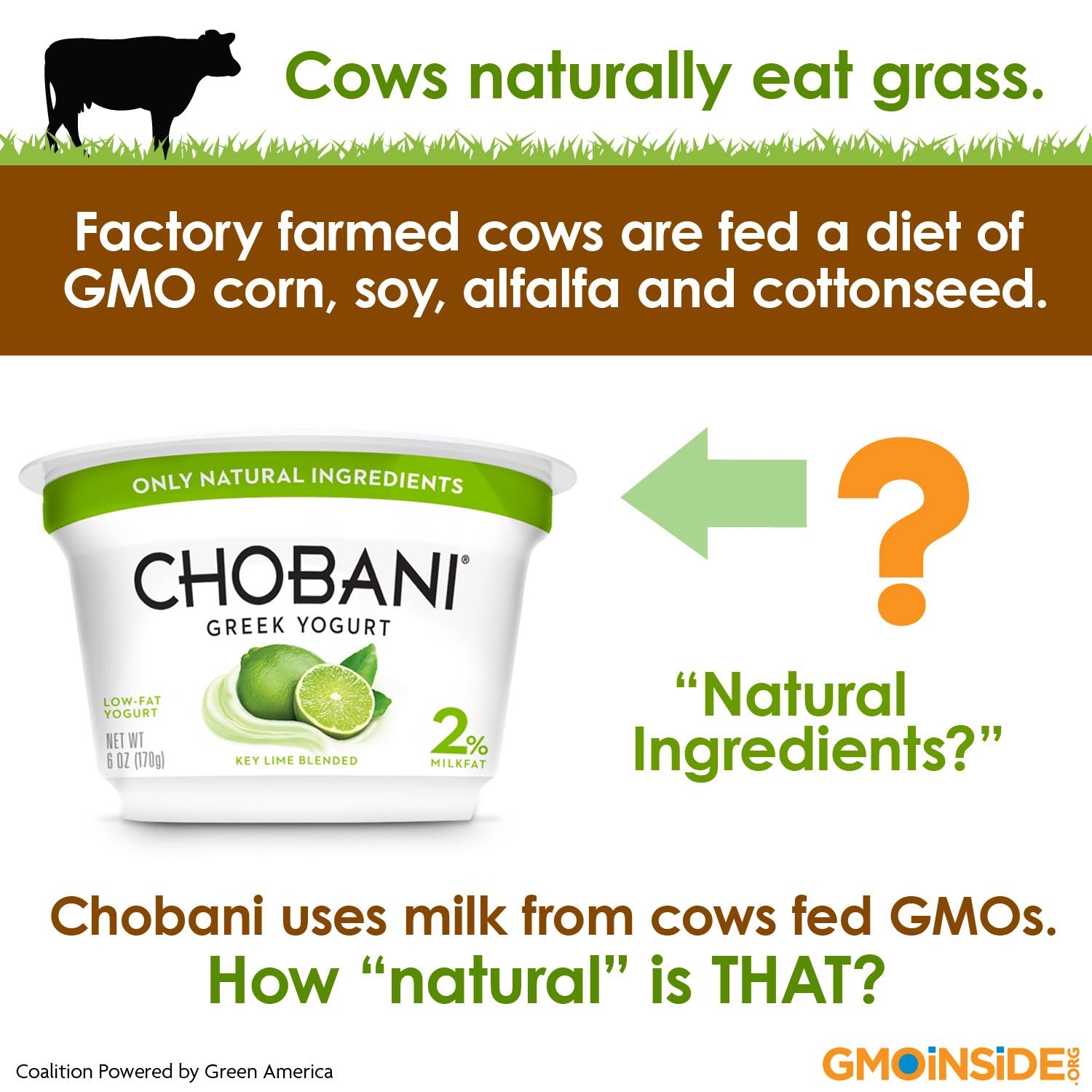 Grocery store aisles across the country are stocked floor to ceiling with yogurt brands, dozens of which fall into the Greek category. So why, amongst all the possible GMO yogurts out there, have we decided to focus our effort on Chobani? Grocery store aisles across the country are stocked floor to ceiling with yogurt brands, dozens of which fall into the Greek category. So why, amongst all the possible GMO yogurts out there, have we decided to focus our effort on Chobani?
We're glad you asked...
1. Chobani is the biggest, with more than 50% market share in the Greek yogurt sector. A change from Chobani could impact the entire food system.
Being big means a number of things:
1) Chobani is relying on a huge volume of milk coming from GMO-fed cows, an estimated 11 million pounds of milk per day! 2) A shift from a company with this much market share will have huge impacts over time in decreasing demand for GMO animal feed. 3) Being big means a company has responsibility to a greater number of stakeholders, including and not limited to dairy cows, dairy farmers, the environment, the communities in which Chobani operates, and consumers. To be sustainable in the long-run, Chobani needs to take the needs of all its stakeholders very seriously.
2. Chobani is a major player in the dairy sector, which is largely dependent on GMOs.
You can't make yogurt without milk and you don't have milk without cows. (And when it comes to Greek yogurt, we're talking a lot of milk. It takes 3-4 times the amount of milk needed to make Greek yogurt compared to regular). Many of the cows in the US, whether living in industrial farms or smaller farms, are fed corn and other GMO crops. In fact, unless specifically segregated and/or organic, its likely that all animal feed in the US contains GMOs, as a majority of the yields of these crops are genetically modified. Reducing GMOs in the animal feed sector will be hugely important to eliminating GMOs from the food system overall.
3. GMO crops have largely failed to deliver on their intended benefits and instead cause harm to the environment, farmers, and the beings that eat them.
In spite of promising higher yields and reduced needs for pesticides, GMO crop outputs have declined overtime and instead require more and more chemicals to fight off immune "super-weeds" in the fields. GMOs have not been proven safe for human consumption, and no independent, long-term studies have been completed. The research that has been done in animals point to health concerns ranging from inflammation to increasing rates of food allergies. Additionally, the GMO DNA in feed has shown to be taken up by animals' organs and detected in the meat, milk, and fish that people eat.
4. Chobani claims to be made with "Only Natural Ingredients" when it in fact relies on genetically modified crops sprayed with chemicals.
Unlike organic Greek yogurt brands which are actually made without chemicals or unnatural ingredients, Chobani relies on milk from cows that are ingesting feed that has been heavily sprayed with chemicals such as Roundup, or in some cases, these crops even have pesticides and herbicides built into their genetic code, like Bt Corn and Roundup Ready Soy. Animals consuming grains that are sprayed with chemicals are known to have health issues and studies have shown that these pesticides pass through the digestive tracts of cows and into their milk. The same milk that people then consume. So how natural is that?
5. Chobani cares about what its consumers want: healthy food.
Chobani lovers are health conscious and actively pursue healthy choices for themselves and their families. Chobani, like all companies, is sensitive to its consumers' demands. However, Chobani consumers hold the brand in a particular halo because they trust Chobani yogurt to be healthy and good for them. When Chobani consumers learn otherwise, they are shocked and feel empowered to speak out. Individuals, speaking together, have incredible power to make change happen. And because Chobani does strive to be a healthy choice, we think they can be a leader and go non-GMO!
Please join us in calling on Chobani to be a leader amongst food manufacturers by committing to work with its suppliers to find non-GMO feed sources for the cows which supply its milk! Sign our petition!
|
|
Are GMOs Good or Bad? The Myths Monsanto Wants You to Believe |
Originally published by The Progressive Mind
by Daisy Luther
July 20, 2013
Monsanto and their biotech buddies would have you believe that they are super-heroes, set on saving hungry children from starvation wearing a dazzling fake-green cape, and may in fact leave you wondering, are GMOs good or bad? In fact, in a recent attack on activists [2], Monsanto’s CEO Hugh Grant said that because critics “can afford” organic food, we don’t care about the plight of those who can’t afford it. “There is this strange kind of reverse elitism: If I’m going to do this, then everything else shouldn’t exist,” said Grant. “There is space in the supermarket shelf for all of us.”
Even Monsanto’s website is on the defense, with page after page attempting to justify what the biotech industry is doing to our food supply. It must be true if even leading “philanthropists” (and I use this term loosely) like Bill and Melinda Gates [3] are behind the distribution of Monsanto crops across the globe. Right?
Actually, it’s all about the public’s perception. The push for acceptance of GMO foods has, thus far, been all about which team has the most money. Monsanto and their ilk can afford more television ads and more PR than anti-GMO activists can. Because the biotech companies, Big Food, and Big Agri can pay to spread their message, many people are convinced by their pure propaganda that GMOs are a necessary evil if the Third World is to avoid millions of slow, agonizing deaths by starvation. Because biotech is able to afford to blanket the media with their perspective, their view point is accepted as the correct one because that is the only perspective that many people ever hear.
But just because they shout the loudest, that doesn’t make it true.
How we address these misconceptions can mean the difference between swaying people to examine these claims more closely or causing them to stick their fingers in their ears and sing, “lalalalala…” to block us out. Here are some of the most common myths that Monsanto and friends would like you to believe about the wonderful world of GMOs.
Myth #1: No one has ever proven that GMOs are harmful to people.
Monsanto mouthpieces have been quoted time, time, and time again stating the untruth that genetically modified organisms have never been proven to harm people. It seems that they believe, like Joseph Goebbels [4], the uncontested King of Propaganda, that if you repeat a lie often enough, and with enough conviction, that it becomes the accepted truth.
The reality: Just a few of the results of a GMO diet (based on peer-reviewed studies) are: grotesque tumors, premature death, organ failure, gastric lesions, liver damage, kidney damage, severe allergic reactions, a viral gene that disrupts human functions…you can read more HERE [5].
Myth #2: GMO crops are the only way to solve world hunger.
The most common pro-GMO argument that you will hear these days is that genetically modified crops are the only way to feed the worlds burgeoning population. Without them, proponents claim that hunger will claim the lives of millions over the next decade. In the gospel of biotech, GMOs are the answer to world hunger. If you protest against GMO technology, you are cast as a cold-hearted elitist and the deaths of all of those suffering children in ***** (pick-a-3rd-world-country) rest firmly on your doorstep.
The reality: Sustainable agricultural practices are the answer to world hunger. GMO farming practices are not sustainable. Farmers who plant GMOs are not able to save their seeds from year to year due to patent infringement and poor fertility in the seeds. Therefore, after getting the first year of good harvests, the following year they must continue buying seeds, leading to perpetual debt and enough financial despair in India (the Bt Cotton scandal [6]) that an Indian farmer took his own life every 30 minutes, after becoming the indentured servant of Monsanto and drowning in insurmountable debt. Well over a quarter of a million farmers died by suicide before the country banned the sale of Bt cotton seeds [7].
Real Change News [8]agrees that biotech farming methods are not the answer to world hunger. They recommend “agroecology”:
Numerous reports from nonprofit, governmental and international organizations have concluded that food can be produced sustainably by bringing ecological principles to agriculture through a practice known as agroecology. The practice supports small-scale, traditional methods of farming and promotes crop diversity over a single-food crop, often referred to as a monoculture. Practicing agroecology also enables farmers to become independent and self-sufficient producers of natural, healthy foods.
Myth #3: GMOs need less pesticide spraying.
Monsanto claims that their Bt products require less spraying. It’s right HERE [9]on their website (emphasis mine):
Crops with a Bt trait have been modified to produce a protein that is toxic to various forms of insect larvae. Bt proteins have long been used as topical sprays in conventional and organic agriculture because they are effective and can be used safely. Crops that are genetically engineered to carry the Bt trait allow farmers to protect their crops while eliminating or significantly decreasing the amount of pesticides sprayed.
The reality: Unfortunately, the best laid schemes of mice, men, and Monsanto often go awry. The Cornucopia Institute reports that was true for the first couple of years, but then use of pesticides and herbicides increased dramatically. (This, of course, resulted in a hefty profit for the producers of those chemicals who are…yep, you guessed it, Monsanto and the other biotech companies who produce the seeds.)
But a n [10]ew study [10] released by Food & Water Watch yesterday finds the goal of reduced chemical use has not panned out as planned. In fact, according to the USDA and EPA data used in the report, the quick adoption [11] of genetically engineered crops by farmers has increased herbicide use over the past 9 years in the U.S. The report follows on the heels of another such study [12] by Washington State University [13]research professor Charles Benbrook just last year.
Both reports focus on “superweeds.” It turns out that spraying a pesticide repeatedly selects for weeds which also resist the chemical. Ever more resistant weeds are then bred, able to withstand increasing amounts – and often different forms – of herbicide.
At the center of debate is the pesticide glyphosate, the active ingredient in Monsanto [14]MON +2.23% [14]‘s Round Up. Food & Water Watch found that the “total volume of glyphosate applied to the three biggest GE crops — corn, cotton and soybeans — increased 10-fold from 15 million pounds in 1996 to 159 million pounds in 2012.” Overall pesticide use decreased only in the first few years GE crops were used (42 percent between 1998 and 2001) and has since then risen by 26 percent from 2001 to 2010.
Other organizations concur and even the mainstream media has been forced to report that pesticide and herbicide usage is on the rise. Check out these recent articles from Huffington Post [15] and Reuters [16] for more information.
Myth #4: GMO technology is comparable to the cross-breeding that our ancestors did to create hardier versions of heritage crops.
Check out this condescending blurb, straight from the horse’s …ummm….mouth (the Monsanto website [17]):
Want to hear something extraordinary? Chances are, almost everything you’ve eaten in your entire life was genetically modified. The same was true for your parents…and your grandparents.
For more than 10,000 years, mankind has selectively bred plants and animals. The cows you see in farmer’s fields bear little resemblance to the ancient Aurochs from which they descended. And the corn you eat is the domesticated version of a wild grass called teosinte.
The reality: What our ancestors did, and what responsible farmers do, is cross-pollination of different varieties of the same plant. It is a low tech method that can occur naturally – but they just gave it a little bit of help in order to bring forth the desirable characteristics, like the drought-hardiness of one type of wheat combined with the shorter growing season required for another type of wheat. This is selective breeding. Genetically modifying seeds is a whole different ballgame, however. Here’s a great explanation from the Food Renegade website [18]:
Unlike hybrid seeds, GMO seeds are not created using natural, low-tech methods. GMO seed varieties are created in a lab using high-tech and sophisticated techniques like gene-splicing.
Furthermore, GMO seeds seldom cross different, but related plants. Often the cross goes far beyond the bounds of nature so that instead of crossing two different, but related varieties of plant, they arecrossing different biological kingdoms — like, say, a bacteria with a plant.
For example, Monsanto has crossed genetic material from a bacteria known as Bt (Bacillus thuringiensis) with corn. The goal was to create a pest-resistant plant. This means that any pests attempting to eat the corn plant will die since the pesticide is part of every cell of the plant.
The resultant GMO plant, known as Bt Corn, is itself registered as a pesticide with the EPA [19], along with other GMO Bt crops. In other words, if you feed this corn to your cattle, your chickens, or yourself, you’ll be feeding them an actual pesticide — not just a smidgeon of pesticide residue.
What’s even worse is that biotech has the ability to produce their seeds with a built in “terminator technology.” This means that the seeds cannot be saved from one year to the next (unlike the cross-pollinated seeds with which they try to claim kinship). Monsanto has patented the technology (called gene use restriction technology [20]) but claims not to use it. This would produce sterile, lifeless seeds that could not be reused, leaving the farmers utterly dependent on the biotech companies for future crops while providing an ongoing stream of income for those companies. At this point they maintain their monopoly through a series of contracts and patents that require the repurchase of seeds annually.
Myth #5: If the FDA and the USDA allow GMO’s, they must be safe to consume.
Organizations like the FDA, the EPA, and the USDA all wear a shiny halo. They receive their power and influence from the mere fact that the public believes that their number one priority is the health and safety of the citizens they are supposed to be serving. All of the agencies vow that they are there to protect the public on their websites:
The FDA [21]:
FDA is responsible for protecting the public health by assuring that foods (except for meat from livestock, poultry and some egg products which are regulated by the U.S. Department of Agriculture [22]) are safe, wholesome, sanitary and properly labeled; ensuring that human and veterinary drugs, and vaccines and other biological products and medical devices intended for human use are safe and effective.
The Vision Statement of the USDA [23]:
To expand economic opportunity through innovation, helping rural America to thrive; to promote agriculture production sustainability that better nourishes Americans while also helping feed others throughout the world; and to preserve and conserve our Nation’s natural resources through restored forests, improved watersheds, and healthy private working lands.
The EPA [24]:
The mission of EPA is to protect human health and the environment. EPA’s purpose is to ensure that all Americans are protected from significant risks to human health and the environment where they live, learn and work…
The reality: All of the above is just feel-good, warm and fuzzy rhetoric. Perhaps there are employees that truly believe in what they’re doing, but the leadership is as sickeningly tainted as Bt Corn.
Part of the reason Monsanto has been so successful in the courtroom has been the company’s incestuous ties to the US de facto government. Despite the blatant conflicts of interest, Monsanto executives have held Cabinet, judicial and policy-making positions in the Bush, Clinton and Obama administrations. When you’re sleeping with the enemy, the enemy tends to get away with all manner of crimes.
- Michael Taylor: VP of Monsanto > Deputy Commissioner of the FDA [25]
- Roger Beachy: Director of the Danforth Plant Science Center (paid for by Monsanto) >director of the USDA National Institute of Food and Agriculture
- Elena Kagan: Obama Solicitor General (when she famously took Monsanto’s side against organic farmers in the Roundup Ready Alfalfa case) > US Supreme Court justice.
- Clarence Thomas: General Counsel for Monsanto > US Supreme Court justice.
- Margaret Miller: Monsanto supervisor > Deputy Director of Human Food Safety
- Donald Rumsfield: Board of Directors for Monsanto’s Searle Pharmaceuticals > US Secretary of Defense
- Ann Veneman: Monsanto Board of Directors > US Secretary of Agriculture
- Linda Fisher: Assistant Administrator at the EPA [26] >VP of Monsanto > Deputy Administrator of the EPA
- Dr. Michael A.Friedman: Deputy Commissioner of the FDA > Senior VP of Monsanto
Make no mistake, the commissioners, directors, and secretaries of these agencies are put in place for a reason. That reason is to grease the wheels for the wealthy biotech firms (and drug companies and Big Food companies and…well, you get the idea). Through an abuse of trust placed in them by the American people, they abuse their power and practice deception on the grandest scale imaginable.
If the FDA, USDA, or the EPA approve something, you might want to view it with more suspicion than acceptance. If they can say that radiation and pesticides are acceptable in your food, but that raw milk isn’t acceptable for consumption…well, there’s something incredibly wrong here.
(Read more about the abuses and deceptions of the EPA [27] and the FDA [28].)
Don't be fooled, don't start to wonder if GMOs aren't as bad as they seem. Educating yourself is a crucial part of being an activist and environmentalist, so continue to learn the truth about GMOs to spread the word.
|
|
EPA Regulation Raises Permissible Levels of Glyphosate in Food |
Originally published by The Washington Times, Communities
July 5, 2013
Laura Sesana
Source article
WASHINGTON, July 5, 2013 – You are what you eat. And now there may be glyphosate in your food. The Environmental Protection Agency (EPA) has raised the permitted tolerance levels of glyphosate residue—the controversial herbicide and active ingredient in Monsanto’s Round Up—in many of the fruits and vegetables that you eat.
Last spring, when the media was clamoring against the Senate’s passing of the so-called “Monsanto Protection Act,” the EPA quietly promoted the rule change regarding glyphosate levels without much attention from the media or public.
The new regulation raises glyphosate levels in oilseed crops, which include sesame, flax, and soybean, from 20 parts per million (ppm), to 40 ppm. It also raises the allowable glyphosate contamination level for sweet potatoes and carrots from 0.2 ppm to 3 ppm for sweet potatoes and 5ppm for carrots, that’s 15 and 25 times the previous levels.
The change in tolerance levels affects several other agricultural products, including animal feed, root crops and fruit trees. While the regulation is effective beginning May 1, 2013, there was an open comment session, closing July 1, that received over 10,800 comments against the proposed change in regulation. It is unlikely, however, that the comments will have any bearing on the decision, which is already final.
Glyphosate, a powerful herbicide, is the active ingredient in Monsanto’s Roundup weed killer, and is the word’s best selling herbicide, used in over 150 crops in over 90 countries. Today glyphosate can be found in products like Roundup, Touchdown, Rodeo, and others.
Monsanto began marketing glyphosate under the Roundup trade name in the 1970s. Roundup quickly became popular and gained even wider use with the introduction of Monsanto’s Roundup Ready crops, which are genetically modified (GM) to withstand glyphosate, enabling farmers to use more of the herbicide to kill weeds without harming the crops. According to the United States Geological Survey (USGS), use of glyphosate has tripled since 1997, due largely to Monsanto’s introduction of Roundup Ready crops.
By 2007, glyphosate was the most widely used herbicide in US agriculture and second most widely used herbicide in the home and garden sector. In that year, the agricultural sector applied 180 to 185 million pounds, the home and garden sector applied five to eight million pounds, and industry, commerce and government applied 13 to 15 million pounds of glyphosate.
The rise in tolerance levels for glyphosate residue came as a result of a petition prepared by Monsanto in early 2012. While FDA did not perform independent tests on whether higher residue levels of glyphosate were dangerous to humans or the environment, it relied on tests and data provided by Monsanto.
Alarmed, many activists believe that a rise in tolerance levels will allow farmers to spray food with more chemicals, which will increase health and environmental risks. While Monsanto (and by default the EPA) guarantees the safety of glyphosate in general and Round Up in particular, recent independent studies conclude the opposite.
Even the EPA’s technical factsheet on glyphosate states that chronic long-term exposure can cause kidney damage and reproductive effects. It also states that and there is “inadequate evidence” as to whether it can cause cancer.
A 2013 MIT study argues that glyphosate residue in food and water induces disease by disrupting normal cellular detoxifying functions. According to the study, “negative impact on the body is insidious and manifests slowly over time as inflammation damages cellular systems throughout the body.” The damage is manifested in increased risk of gastrointestinal disorders, obesity, diabetes, heart disease, depression, autism, infertility, cancer and Alzheimer’s disease.
In another recent European study, commissioned by Friends of The Earth (FoE) and GM Freeze, volunteers from 18 countries submitted urine samples to be tested for traces of glyphosate. All of the volunteers lived in cities and had never used or handled glyphosate prior to the test. Laboratory tests concluded that 44% of people had traces of glyphosate in their urine. The rate of positive samples varied by country, with Malta, Germany, the UK, and Poland having the highest rates and Switzerland and Macedonia having the lowest rates.
Finally, who other than Monsanto will benefit from this raise in tolerance levels in the long run? While farmers may benefit for a short while because being able to spray more herbicide may give them a larger crop yield, it may be possible that other countries will refuse to import U.S. produce due to the higher tolerance levels.
After all, it was a little over a month ago that Japan refused to buy U.S. wheat after a strain of unapproved Monsanto GMO wheat was unexplainably found in an Oregon field. A week before that China incinerated three shipments of U.S. corn after discovering it contained unsanctioned GMO corn.
It is unclear whether the EPA took the above independent and other studies into account when making its decision to raise glyphosate residue tolerance levels in many of the foods we eat. Monsanto and corporate agriculture will argue, as they usually do, that the new tolerant levels are “insignificant” and could not harm humans. Many disagree.
The bottom line is that the items in your produce department may be a little more poisonous today than they were a few months ago. It's always critical to know what you put in your body or feed your family, so stay tuned for future developments about chemicals, pesticides, and herbicides like glyphosate in your food.
|
|
GMO Foods Strike Again with Chobani Yogurt |
Originally published by Brand Channel
by Dale Buss
July 17, 2013
Source article
Chobani yogurt, one of the country's fastest-growing CPG brands, is the latest to come under scrutiny from an activist group over its use of GMOs.
GMO Inside, an organization led by environmental group Green America, is calling on the Greek-yogurt segment leader to stop marketing its products as "real" and "natural" until it stops using milk from cows that are fed genetically-modified feed, adding Chobani to the overflowing list of GMO foods. The move represents one of the first attempts by US GMO activists to target dairy brands in addition to the cereal, bakery and grocery brands that have previously come under fire.
"So much of the GMO crops are going to animal feeds, so if we could change the way this is happening it could help to convert a lot of cropland back to non-GMO production," Elizabeth O'Connell, campaign director for the GMO Inside NGO, told Advertising Age.
The challenge is a direct hit to Chobani's ongoing "Go Real" campaign, which launched in February. Upon visiting its website, consumers are bombarded with videos and diagrams detailing the brand's natural ingredients, including an illustration that tracks Chobani's farm-to-factory process.
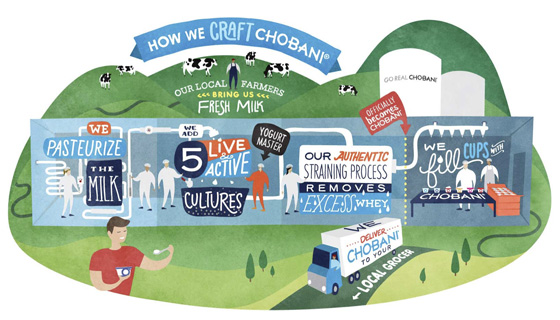
As CPG brands typically have done so far in this debate, Chobani pointed in the direction of arguments such as how GMOs make foods more affordable and how they haven't been proven unsafe.
"GMO is complex and weighs on the balance of our commitments, particularly affordability, as non-GMO ingredients are fewer and more costly," Chobani's statement said. "We are in the infancy of exploring how we as a company, together with our suppliers, will navigate this important issue. We have never made claims that our products are GMO-free."
Another big dairy brand that has already laid out its GMO policy is Ben & Jerry's, the Unilever-owned ice cream maker that has made a reputation of continuing the activism of its two founders. The Vermont-based brand has pledged to eliminate non-GMO ingredients in its US products by the end of this year—as it already has in Europe—or label those vestigial elements that remain into 2014.
Already in the US and Canada, about 80 percent of Ben & Jerry's ingredients by volume are sourced non-GMO. "We're working mostly on the remaining chunks and swirls that we add in at this point," brand spokesman Sean Greenwood told CPGmatters.com.
Another progressive brand, Whole Foods Markets, has committed to labeling all products in its US and Canadian stores that contain GMOs by 2018. Fast-growing Trader Joe's, another bellwether chain, has responded to anti-GMO critics in part by noting the non-GMO choices it gives its customers, including organic foods.
Chobani isn't the only brand coming under fire for blurring the line between "natural" and GMO-free. PepsiCo-owned Naked Juice just agreed to stop using "all natural" to describe its products after settling a class-action suit for $9 million, citing the lack of global "detailed regulatory guidance around the word 'natural.'" Use of GMO soy also is part of the issue with Naked Juice labeling.
|
|
How Pervasive are GMOs in Animal Feed? |
Despite wide-ranging concerns relating to genetically modified foods and crops, the use of GMOs in farming has increased annually since the technology’s commercial introduction in 1996. According to the ISAAA, an international organization that supports crop biotechnology, biotech crops have increased 100-fold, from 1.7 million hectares (4.2 million acres) in 1996, to 170 million hectares (420 million acres) in 2012. These 170 million hectares mean that GMO crops now occupy over 10% of the world’s arable land. 1 While these statistics show how widespread GMO crop usage has become and how lucrative GMO seeds have been for the biotech industry over these last 17 years, it is important to note that with the growth of GMO use there still has not been a clear reflection of improvements for crop yields or for benefits for the welfare of the actual farmers growing GMOs. Figure 1.
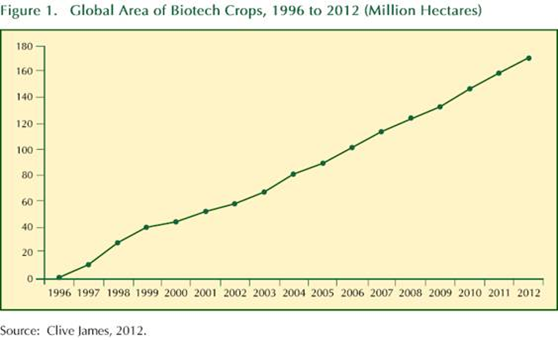
In 2012, 17.3 million farmers grew GMO crops 1, and 9 countries grow 97% of world’s GM crops. Together, the US, Brazil, Argentina grow 76.3% of the world’s GM crops 2. A graphic from Mother Jones shows these ISAA statistics: Figure 2.
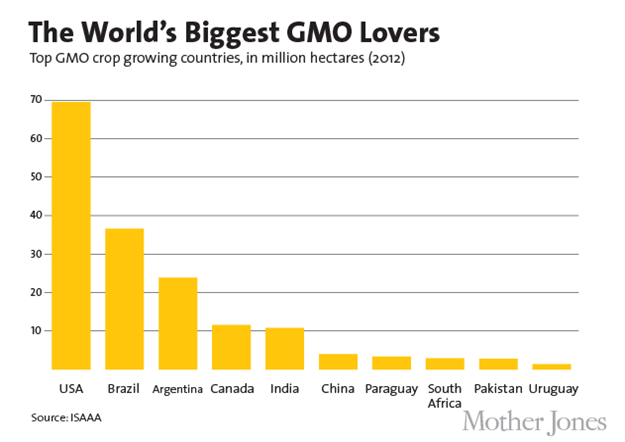
Worldwide, 8 GMO crops have been approved for commercial production; soy, cotton, corn, canola, sugarbeet, papaya, squash or yellow zucchini, and alfalfa, and the biotech industry is in the process of pushing forward additionally modified foods such as rice, apples, and salmon. The four major crops that account for virtually all of the biotech output are soy, cotton, corn, and canola. The remaining GMO crops are exclusively grown in the United States with the exception being papaya which is grown in China in addition to US cultivation. Figure 3.

Figure 3 shows the pervasiveness of GMOs in global crops; but in the United States, where every possible approved commercial GM crop is grown, the numbers are even more striking. Recent statistics show that GM varieties account for approximately:
- 94% of US soy crops (which by volume accounts for just under half of all the GM crops grown worldwide)
- 94% of US cotton plantings
- 92% of the US corn crop
- 94% of the US canola crop
- 98.5% of US sugar beet plantings
- Alfalfa (first planted in 2011)
- Papaya (most of Hawaiian crop; approximately 988 acres)
- Zucchini, yellow summer squash (approximately 25,000 acres)
Figure 4.
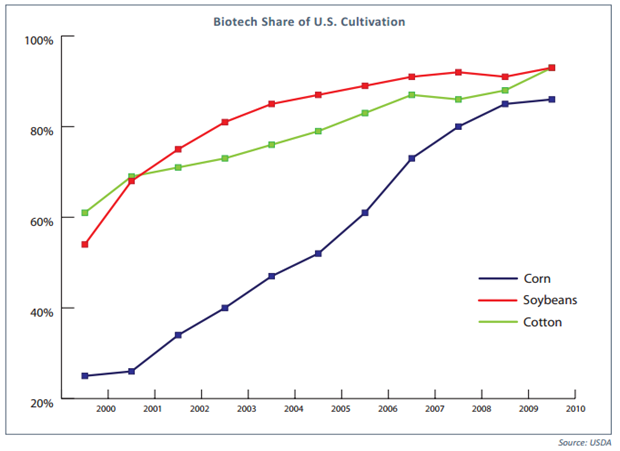
Where do these GMOs go? While supporters of GMO crops argue that GMOs are essential to feeding a growing world population, the truth is that in the United States (the world’s foremost GMO producer and consumer) and in other major GMO producing countries, an overwhelming majority of the GMO crop is not even consumed directly by humans. In the US, livestock has been fed genetically engineered crops since these crops were first introduced in 1996 and each of the top 6 GMO crops (soy, cotton, corn, canola, sugar beet, and alfalfa) are heavily utilized by the US and global animal feed market. The US, Brazil, China are world leaders of commercially produced animal feed--and these countries are also some of the largest producers of GMO crops (see Figure 2). Public consciousness for the pervasiveness of GMOs in the feed of the animals that produce our eggs, meat, and dairy is extremely low, but it is no coincidence that the largest animal feed producing countries in the world are also the largest producers and consumers of GMOs. Commercial animal feed is composed directly from harvest crops and the leftovers of processed crops. Some of the most common commodity feed ingredients are soy, cotton, corn, canola, sugar beets, and alfalfa. Seeing that the countries that produce the most animal feed--the United States, Brazil, and China--are all leaders in GMO production, it is very clear that their animal feed products are consequently composed of significant amounts of GMOs.
- The commercial animal feed industry is by far the largest purchaser of US corn and soybean meal; the majority of these US crops are genetically modified: corn 88% and soybeans 94%.
- Of the two largest GMO crops in the United States, 98% soy and 79.5% of corn goes directly into feeding animals and fueling cars in the US. 34
Figure 5.
Taking a Look at Common Commodity Feed Ingredients: Soy
- Soybean meal is the largest protein meal produced in the world; GMO soybeans are widespread in the main soybean producing countries
- 90% of the world’s soy is used to feed animals 5
- 98% of the soy in the US goes into livestock feeding and car fuel production, with by-products of this used for food ingredients such as lecithin and oils 3
Figure 6.

- 94% of the US soy crop is genetically modified
Cotton
- Cotton is used for more than textiles. It is also an ingredient in animal feed and for various processed foods. 6
- The United States, China, and India together provide two-thirds of the world's cotton. These are also the three countries with the largest percentages of pervasiveness for GMO in their cotton crop production
- The United States, which ranks third in production behind China and India, is the leading exporter, accounting for over one-third of global trade in raw cotton. 7
Figure 7.

- 90% of the US cotton crop is genetically modified
Corn
- Corn is a major feedstuff ingredient, particularly in developed countries. Dairy cows, beef cattle, pigs, sheep, goats, poultry, and fish, and rabbits are fed corn in the US 8
- 32% of the world’s corn supply is grown in the United States. The US is the largest producer of corn.
Figure 8.
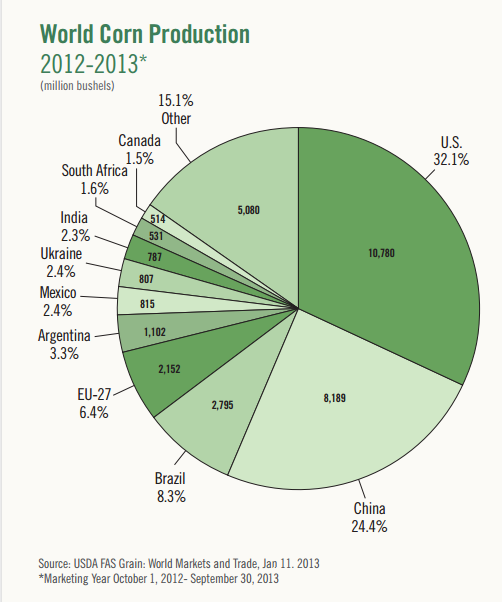
- According to the National Corn Growers Association, now about eighty percent of all corn grown in the US is consumed by domestic and overseas livestock, poultry, fish, and fuel production. 4
- 88% of the US corn crop is genetically modified.
Canola
- Canola meal is one of the most widely used protein sources in animal feed for livestock, poultry, and fish. 9
- Approximately 43% of a canola seed is oil. What remains is a canola meal that is used as an ingredient in animal feed. 10
- Canada, the largest single country producer of Canola, exports 85% of their canola.11 According to the ISAAA, 97.5% of the canola grown in Canada last year was genetically modified. The biggest buyer of canola oil and meal for animal feed is the United States.
- The United States also produces its own canola in states adjacent to Canada - North Dakota, Montana and Minnesota produce over 90 percent of the nation's canola crop.12
- 90% of the US canola crop is genetically modified.
Sugar Beet
- Sugar Beet Pulp – Sugar beets are processed so that the sugar stored in the beet root is separated from the rest of the plant material. The sugar beets are boiled in water and the resulting sugar-containing juice is filtered, concentrated into a thick syrup, and then washed in a spinning centrifuge to separate sugar, molasses, and dried beet pulp. After sugar and molasses have been recovered from the sugar beet, the remaining pulp is utilized for animal feed.
- 57% of American sugar production comes from sugar beets, the rest from sugar cane. 13
- 95% of the US sugar beet crop is genetically modified.
Alfalfa
- Dairy cows are the primary consumers of alfalfa hay .
- GM-alfalfa was first approved in 2011.
Feed Market The American commodity feed industry heavily impacts the global market. The US accounts for 22% of global output according to the International Feed Industry Federation 14. Other major GMO producing countries in South America and Asia are also accountable for large contributions to commercial animal feed production. Figure 9.
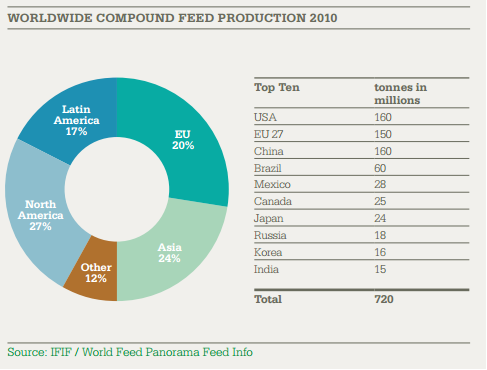
In the United States, unlike most other developed countries, there are no specific regulations for foods or products manufactured using GMOs. While GMO labeling is required in 64 countries to various degrees (more here) around the world – only a few countries, like Brazil, Venezuela, and members of the EU also require labels for animal feed that contain GMOs. Brazil is an important country to note, because even though this country is one of the strongest supporters and producers of GMOs, they still allow their citizens to make informed decisions by labeling their animal feed if it contains GMOs. For livestock farmers in the US this remains a mystery, but if the animal feed is not organic or non-GMO verified, it almost certainly contains GMOs. However, many countries that have food labeling laws do not have labeling requirements for animal feed, or for animal products produced from animals fed GMO crops. This loophole, where the GMO label is not applied to food products made from animals raised on GMOs, is responsible for a large amount of unnoticed GMO consumption. This loophole and other laws that allow GMOs to be a hidden part of the food system, mean that products like meat, eggs, and milk that were produced by animals consuming GMOs are able to enter the marketplace free of any GMO labeling. The United States of course, infamous for the pervasiveness of GMOs and the country’s lack of labeling laws, does not have to deal with the particular complexities of GMO animal feed labeling. In the United States, in order to avoid animal products that have not been influenced by GMO animal feed, consumers have to look for certified organic products (since organic standards prohibit the intentional use of GMOs) and for the recently release Non-GMO Project certification for meat, egg, and dairy products. The pervasiveness of GMOs in animal feed, also makes it a challenge for organic producers to secure uncontaminated organic feed. This is a challenge that will continue to grow if GMO crops are allowed to continue their land cover growth as a result of limited supply, increasing the risk of irreversible cross-contamination. Without clear labeling laws, consumers are being deceived into thinking they are not contributing to the consumption and production of GMOs. However, the statistics show that GMOs are hidden in our everyday foods and consumed by the animals that produce the meat, eggs, and dairy products that Americans consume in vast quantities.
___________________________________________________
Take action today by calling on #1 US yogurt brand Chobani… Chobani is the United States’ top Greek yogurt brand and it prides itself on adding no GMO ingredients to its yogurt. However, it is likely that the company is relying on milk from cows eating a diet of genetically modified organisms. GMO Inside, a national coalition led by Green America, is calling on Chobani to cease marketing its products as “real” and “natural” until the company switches to verified non-GMO milk sources. Tell Chobani to shift to non-GMO feed for their cows, to help accelerate the shift to a non-GMO food system! We and the cows thank you.
___________________________________________________
Resources 1 http://www.isaaa.org/resources/publications/briefs/44/executivesummary/default.asp 2 http://www.cban.ca/Press/Press-Releases/Global-Growth-of-GM-Crops-Overblown-ISAAA-yearly-report-misleads-says-CBAN 3 http://inspiredeconomist.com/2013/02/26/economic-argument-against-gmo/ 4 http://www.ncga.com/upload/files/documents/pdf/WOC%202013.pdf 5 Brown, L., 1999. The United States and China, the Soybean Connection. Worldwatch Institute, November 9, 1999. 6 http://www.gmo-compass.org/eng/grocery_shopping/crops/161.genetically_modified_cotton.html 7. http://www.ers.usda.gov/topics/crops/cotton-wool.aspx#.UeJy49I3uCc 8. http://www.feedipedia.org/node/71 9. http://www.uscanola.com/site/epage/102391_956.htm 10. http://canolacouncil.org/media/503589/canola_guide_english_2009_small.pdf 11. http://www.canolacouncil.org/markets-stats/markets/ 12. http://www.agmrc.org/commodities__products/grains__oilseeds/canola-profile/ 13. http://www.sugaralliance.org/more-sugar-facts. 14. http://www.ifif.org/uploadImage/2012/1/4/f41c7f95817b4c99782bef7abe8082dd1325696464.pdf
|
|
Nike's Free App Provides Resources for Sustainable Designers |

Nike is launching a free mobile app called Making that allows designers to research fabrics or materials, tapping into years of Nike research into sustainability.
Making, available initially for Apple iOS, works by allowing designers to research fabrics or materials they'd like to use. The software publicly exposes information from an internal database amassed over the past eight years, the Nike Materials Sustainability Index (MSI), which has also been embraced by the Sustainable Apparel Coalition as part of its Higgs Index.
The app has a use for consumers, too, who could access it to check out the materials choices that their favorite apparel brands are making.
Nike's MSI was originally created for internal use, but the company decided to open the information to other designers to accelerate creation of sustainable products. The app offers feedback on the environmental impact for 22 commonly used apparel materials in four different areas: water consumption, chemistry, energy and waste. Get more details on the Nike sustainable materials app Making from GreenBiz.com.
The Sustainable Apparel Coalition represents 80 leading apparel and footwear brands, retailers, suppliers, nonprofits and NGOs, that work towards reducing the environmental and social impact of the fashion industry.
|
|
Are there GMOs hiding in your Chobani Greek yogurt? |
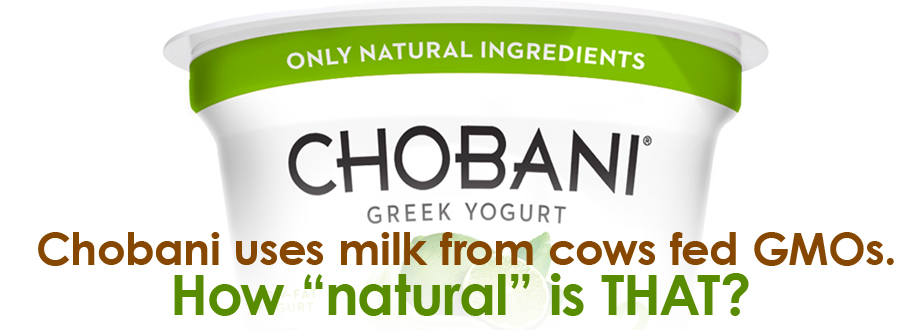
Join us on calling on Chobani – the most popular US yogurt brand – to shift to non-GMO feed for their cows! (Take action here!)
Chobani Greek Yogurt is one of the common foods with GMOs that surprise people, often because it is touted as a "natural" and healthy source of protein. But if you thought that one way to cut GMOs from your diet was to avoid foods with high-risk GMO ingredients, think again.
Meat and dairy products, while not genetically modified themselves (yet[1]), are not immune to the insidious impacts of GMOs. In fact, your favorite yogurt brand may be made with “Monsanto Milk” – milk from cows that are fed GMO silage.
Cows living on industrial farms eat GMO feed two to three times a day, every day. This silage may consist of GMO corn, soy, alfalfa, cotton seed, and/or sugar beets, plus synthetic vitamins that are often times also derived from GMO crops. In fact, 98% of GM soy and 49% of GM corn goes to feeding livestock and poultry.
Animals, like humans, are deeply impacted by the quality of their diets. A recent study showed that pigs fed an entirely GMO diet suffered from severe stomach inflammation when compared to pigs given non-GMO feed.0[2] Additionally, while industry has claimed that genetically modified particles are broken down in the digestive tracts of the animals that eat them, these GM particles have shown up in the organs and milk of animals fed GMOs, the same milk and meat that humans then eat.[3]
Greek yogurt, popular today for its high protein content, is likely made with milk from cows fed GMOs, unless otherwise specified. It’s impossible for consumers to know which meat and dairy products are derived from GMO-fed livestock, unless the product has gone through the Non-GMO Project’s certification for non-GMO feed, recently approved by the USDA as a credible label.[4] Even more than regular yogurt, Greek yogurt relies on a lot of “Monsanto Milk” since it is strained more than regular yogurt (It takes roughly 4 ounces of milk to make 1 ounce of Greek Yogurt). And Greek yogurt is gaining in popularity every day!
Chobani, the US’s number one Greek yogurt brand, which markets itself as being “real” and “natural”, in fact most likely uses milk gathered from cows who are fed GMOs. Chobani prides itself in adding no GMO ingredients to its yogurt, but its main ingredient, milk, is coming from cows that are eating GMOs. Chobani also said on facebook that it is carefully monitoring its customers' concerns when it comes to GMOs, so it’s time to speak up!
We hope you will join us in calling on Chobani Greek Yogurt to shift to non-GMO feed for their cows, to help accelerate the shift to a non GMO food system! Take action now!
And in the meantime, we hope you will choose organic and non-GMO verified Greek yogurt choices for your family, such as Stonyfield Farm or Straus Family Creamery. Please leave a comment and share your own suggestions or recipes for non-GMO yogurt.
[1] At present, the FDA has approved 8 genetically modified crops to be grown and sold in the US. (And even without approval, GMO wheat has turned up in Oregon). To date, no animals have been approved to be genetically modified, but salmon has been proposed. While livestock and poultry are not themselves genetically modified, they are often fed GMO feed.
|
|
GMOs: The Uninvited Guest at Your Picnic |

The season of charcoal smells and checkered tablecloths has begun. It's a great time to get together with family and friends to share laughs and delicious food. However, there may be an uninvited guest at your picnic or BBQ - GMOs. Unfortunately, almost everything on our typical plate is likely to have some GM ingredients, from the ketchup to the bun. Sometimes these GMOs are disguised and, unfortunately, often overlooked.
Adding to the discreet infiltration of GMOs is the fact that meat, dairy, and eggs - even though not genetically modified themselves - are produced using GMOs. Corn and soy make up the majority of animal feed in the US. With 88% of corn and 93% of soy in the US grown genetically modified, our farm animals are raised on GMOs. Animals, like humans, are deeply impacted by the quality of their diets. One study showed that pigs fed an entirely GMO diet suffered from severe stomach inflammation when compared to pigs given non-GMO feed. Their GMO-fed bodies are then turned into food for us.
So before you head off to your Fourth of July picnics and BBQs, review the picnic items below for likely GM ingredients and tasty non-GMO alternatives. Then share the knowledge. While the topic of GMOs has hit the mainstream, not everyone knows all the facts or understands the destruction GMOs are causing to our planet and our bodies. So use this season of gathering as an opportunity to talk to your loved ones about GMOs.
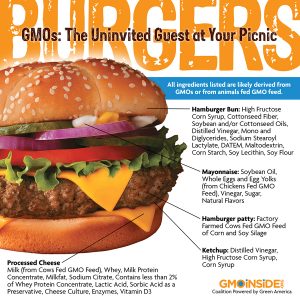
GMO Picnic Items (and Better Options)
Buns - High Fructose Corn Syrup, Cottonseed Fiber, Vegetable Oil (Soybean And/Or Cottonseed Oils), Distilled Vinegar (often derived from corn), Mono and diglyceride (often derived from soybean, cottonseed, corn, canola), Sodium Stearoyl Lactylate (stearic acid maybe from soy), DATEM (usually derived from soy or canola oil), Maltodextrin (maybe from corn), Corn Starch, Soy Lecithin, Soy Flour
 Non-GMO/organic option: Rudi's Bakery, Berlin Natural Bakery, Ener-G Foods, Silver Hills Sprouted Bakery, local bakery Non-GMO/organic option: Rudi's Bakery, Berlin Natural Bakery, Ener-G Foods, Silver Hills Sprouted Bakery, local bakery
Veggie Burger (meat-free) - Textured Vegetable Protein (Soy Protein Concentrate), Corn Oil, Canola Oil, Hydrolyzed Vegetable Protein (Corn Gluten, Soy Protein), Dextrose, Soy Protein Isolate, Natural And Artificial Flavors From Non-Meat Sources, Maltodextrin, Soy Sauce, Soy Lecithin
 Non-GMO/organic option: Sunshine Burgers (also wheat-free and vegan!), Hilary's Eat Well Burgers (also gluten-free and vegan!), Amy's Veggie Burgers (also vegan options) Non-GMO/organic option: Sunshine Burgers (also wheat-free and vegan!), Hilary's Eat Well Burgers (also gluten-free and vegan!), Amy's Veggie Burgers (also vegan options)
Meat Burger - Cows Fed Corn and Soy Silage
 Non-GMO/organic option: Cows raised on an actual farm, allowed to graze, and fed roughage. Applegate Organic Beef and Turkey Burgers, Organic Prairie Organic Burgers (Organic Valley), check out your local farmers market Non-GMO/organic option: Cows raised on an actual farm, allowed to graze, and fed roughage. Applegate Organic Beef and Turkey Burgers, Organic Prairie Organic Burgers (Organic Valley), check out your local farmers market
Hot Dog - Mechanically Separated Turkey (fed GMOs), Mechanically Separated Chicken (fed GMOs), Pork (fed GMOs), Corn Syrup, Flavor
 Non-GMO/organic option: Applegate Organic Beef and Pork Hot Dogs, Organic Prairie Organic Hot Dogs (Organic Valley), check out your local farmers market Non-GMO/organic option: Applegate Organic Beef and Pork Hot Dogs, Organic Prairie Organic Hot Dogs (Organic Valley), check out your local farmers market
Veggie Hot Dog (meat-free) - Corn Syrup Solids, Methylcellulose (sometimes from corn), Dextrose, Egg Whites, Natural Flavors, Sugar, Hydrolyzed Vegetable Protein (Corn Protein, Soy Protein), Hydrolyzed Corn Protein, Soy Protein Isolate, Maltodextrin, Xanthan Gum, Hydrolyzed Soy Protein, Soybeans, Hydrolyzed Vegetable Protein (Corn Gluten, Soy Protein), Soybean Oil, Citric Acid
 Non-GMO/organic option: Field Roast Frankfurters Non-GMO/organic option: Field Roast Frankfurters
Ketchup - Distilled Vinegar, High Fructose Corn Syrup, Corn Syrup
 Non-GMO/organic option: Annie’s Organic Ketchup Non-GMO/organic option: Annie’s Organic Ketchup
Mustard - Distilled Vinegar, Natural Flavors
 Non-GMO/organic option: Annie’s Organic Yellow Mustard, Eden’s Organic Yellow Mustard Non-GMO/organic option: Annie’s Organic Yellow Mustard, Eden’s Organic Yellow Mustard
Pickle Relish - Sugar, High Fructose Corn Syrup, Vinegar, Xanthan Gum, Natural Flavors, Polysorbate 80
 Non-GMO/organic option: Bubbie’s Pure Kosher Dill Relish (no sugar), Woodstock Organic Sweet Relish Non-GMO/organic option: Bubbie’s Pure Kosher Dill Relish (no sugar), Woodstock Organic Sweet Relish
Mayonnaise – Soybean Oil, Whole Eggs And Egg Yolks, Vinegar, Sugar, Natural Flavors
 Non-GMO/organic option: Woodstock Mayonnaise, Earth Balance Mindfulmayo Non-GMO/organic option: Woodstock Mayonnaise, Earth Balance Mindfulmayo
Processed Cheese – Milk (cows fed GMOs), Whey, Milk Protein Concentrate, Milkfat, Lactic Acid, Artificial Color, Enzymes
 Non-GMO/organic option: Organic Valley cheese, Rumiano Family Cheese, any organic cheese Non-GMO/organic option: Organic Valley cheese, Rumiano Family Cheese, any organic cheese
Chips - Soybean oil and/or Canola oil; Corn if corn chips; possibly Sugar, High Fructose Corn Syrup, Natural Flavor, Maltodextrin, and many more depending on chip flavor
 Non-GMO/organic option: Kettle Brand Chips, Boulder Canyon Chips Non-GMO/organic option: Kettle Brand Chips, Boulder Canyon Chips
Soda - High Fructose Corn Syrup, Caramel Color, Sugar, Citric Acid, Natural Flavor
 Non-GMO/organic option: DRY Soda, Reed's Ginger Brew, SANS All Natural Soda Non-GMO/organic option: DRY Soda, Reed's Ginger Brew, SANS All Natural Soda
Sweet Corn - GM varieties entered the market last year
 buy organic buy organic
You can always buy other brands that you like too. Just look for the Non-GMO Project or USDA Organic labels to stay away from GMOs.

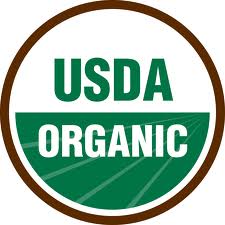
|
|
Toxic Chemicals in Schools |
School is your child’s second home, a place where they spend one-third of their day. Yet, student, faculty and staff health is compromised and adversely affected everyday by toxic chemicals found in cleaning products, pesticides, and food served in the school. As schools become increasingly laden with toxic chemicals, the issue of chemicals in schools becomes ever more crucial.
|
Toxicants commonly
found in schools:
|
|
Lead
(paint, drinking water, cleaning products)
|
|
Air pollution
(toxics from chemicals in cleaning products)
|
|
Pesticides
(classrooms, cafeterias, school lawns, playground, playing fields)
|
|
Arsenic
(arsenic-treated
wood in playgrounds)
|
|
Mercury
(cleaning products, glue,
dry erase markers, etc.)
|
|
Asbestos
(cleaning products, glue,
dry erase markers, etc.)
|
|
Formaldehyde
(cleaning products, glue,
dry erase markers, etc.)
|
According to the US Environmental Protection Agency (EPA), at least half of the approximately 53 million students and five million staff “may be exposed to polluted indoor air, lead, asbestos, chemical fumes, pesticides, molds and other toxins.” Traditional cleaning products and pesticides contain harmful chemicals that are known to cause cancer, asthma, reproductive disorders and major organ damage, among other health ailments. In fact, “one out of every three cleaning chemicals used to clean school buildings in the United States is known to cause human health or environmental problems,” explains Mary Jo Snavely, the Center for a New American Dream’s Responsible Purchasing Network/Marketplace Associate. Health alone is not the only negative outcome of these toxicants; they can also cause a dramatic drop in student performance and school attendance.
This means that now is the time for action. There are healthier alternatives and solutions to reducing school toxicants, in the form of community organizations working to ensure that schools are as toxicant-free as possible. So now it is up to parents and even the students themselves to take the initiative and begin the process of minimizing toxins in schools.
One organization working towards creating a toxic-free school environment is the Center for Health, Environment and Justice (CHEJ). Through CHEJ’s Green Flag Program, students advocate for school-wide reforms to make their schools safer and healthier.
In cooperation with CHEJ, parents, students, and faculty can form a “Green Committee” that conducts an environmental assessment of the school, such as looking at cleaning products being used, how pests are controlled, products used for construction materials and the ventilation system. CHEJ’s Stacey Gonzalez explains that a Green Committee is necessary because “you need them to be part of the conversation and keep the school toxin-free. The Committee holds the school responsible to continue [with green improvements] and move forward.”
Another component of the Green Flag Program is the joint project between CHEJ and GreenFaith, which Stacey Kennealy, project coordinator for GreenFaith, describes as “an interfaith environmental coalition based in New Jersey” and is open to all schools.
Student Shayna Schor, believes the changes she helped make through her school’s GreenFaith Program will have a lasting effect. As Shayna explains, “People now know that by incorporating even the most minor eco-friendly differences into our daily routines, wecontribute toa healthierfuture of our planet.”
The Green Flag/GreenFaith Program does not have to stop at schools either. Adi Segal, another student at Solomon Schechter Day School, started a Green Camp Initiative at her summer camp, where recycling was “effectively accomplished throughout the bunks and a large-scale ‘ad campaign’ was launched to increase awareness about ‘green’ living in camp.”
Another solution, Stacey suggests, is to “look at what the contract says with vendors the school purchases products from.” Find out if they mention anything about using toxic-free chemicals. If they do, it is easy to find healthy cleaning methods that should be part of the contract. There are hundreds of cleaning products certified by Green Seal and/or EcoLogo. New Dream's responsible purchasing center features a list of recommended certified products.
If you would like your school to join CHEJ’s Green Flag Program, you can register for free at www.greenflagschools.org.
Another solution is establishing a Green Cleaning Program at your school to protect students, faculty and staff health against toxic chemicals without harming the environment. This program replaces toxic chemical-loaded cleaning products with certified green cleaning ones.
Developing and implementing a Green Cleaning Program does not have to be expensive either. There are many manufacturers who offer “certified” green cleaning chemicals that are cost-competitive compared to traditional products. So, find suppliers with “certified” green cleaning products and create guidelines for their use in your school.
|
Five Simple Steps to a Healthy School Environment
|
|
1. Switch to green cleaning products.
|
|
2. Introduce green equipment and supplies.
|
|
3. Adopt green cleaning procedures.
|
|
4. Use green paper and plastic products.
|
|
5. Share the responsibility.
|
|
|
An additional solution to reducing the amount of toxicants in schools is to ensure that the school serves locally grown food in the cafeteria. The food served in schools is especially critical to a toxic-chemical-free environment because “research has shown that kids are 2-3 times more susceptible to absorbing the harmful toxins in food, on a pound-by-pound basis, than adults,” explains Anupama Joshi, Occidental College’s Center for Food & Justice Director. Anupama also notes that “the school meal is the major meal of the day for low-income kids.” Therefore, we need to “be a lot more careful about the food served in cafeterias and track the source of food.”
Since many local producers are turning to organic growing methods, local food usually means fewer pesticides in kids’ school lunches.
The Farm-to-School lunch program, headed by The Center for Food and Justice, connects schools with local farms to provide healthy cafeteria food, while incorporating nutrition-based curriculum and supporting local farmers. According to Anupama, “Farm-to-School focuses on providing healthy, safer alternatives. Because smaller-scale farmers use sustainable methods of farming, even if the food is not certified organic, it is still a better quality.”
The program is nationally based, with 10,943 schools in 34 states currently involved. The schools that take part in this program buy farm-fresh, local foods, such as fruits, vegetables, eggs and beans, and serve them in the cafeteria.
The program not only consists of healthier food options in the school cafeteria, but also education about where the food is coming from and how it affects our health. It also includes an education component for cafeteria staff on dealing with fresh products by properly cooking, cleaning, and presenting the food to the students so it is an attractive option for them. Schools also participate in a gardening or recycling project or a waste management program, as well as having hands-on experience with field trips to the farms themselves and cooking demonstrations in the classroom.
To implement the Farms-to-Schools program at your school, you can order a free information resource packet from the Farm-to-School Web site at www.farmtoschool.org. The Web site provides information on local contacts to get in touch with and get a sense about what’s happening locally in terms of options for connecting with local farmers.
The U.S. Department of Agriculture (USDA) also runs a similarly focused program called Small Farms/School Meals. To learn more, check out the agency’s “Step-by-Step Guide on How to Bring Small Farms and Local Schools Together,” which is available online at www.usda.gov.
A fourth solution to reducing the amount of toxic chemicals in schools involves the elimination of pesticides sprayed on the school buildings themselves, which are extremely hazardous to children’s health. There are several important steps parents and students can follow to ensure that their school is pesticide-free.
Parents can help protect the health of children by working to establish Integrated Pest Management (IPM) in their schools, a proven alternative to pesticide use. IPM is a progressive process that starts with the least harmful methods of pest prevention and progresses to more intense chemical methods until the problem is solved.
With IPM, non-chemical methods of managing pests are used first. These methods can include restricting where food is eaten, moving the dumpster away from the school, repairing and maintaining leaking pipes and pressure cleaning food service areas.
If all non-chemical methods of managing pests do not work and a pest problem still persists, requiring the need for pesticide use,a school's pest companyshould use the least-toxic pesticide available, only applying the pesticide to the infested areas. Boric acid is a good option, as it has relatively low toxicity compared to other pesticides, does not evaporate into the air and therefore does not cause indoor air pollution. It is important to use boric acid with less than one percent of inert ingredients so you have a better idea about what you are applying and the risks involved, compared to other pesticides. Only use a more chemically-powerful pesticide if none of the above options work. And in the case that a stronger pesticide is absolutely necessary, use it in as minimal an area as possible.
To establish IPM at your school, the Iowa School’s IPM System recommends the following procedure: First, talk with the principal and teacher about what is being done to control pests in the school. Second, find other parents who share concerns about pesticide exposure. Third, form a school IPM advisory committee with the school’s administration and adopt an IPM policy. For more information, go to www.ipm.iastate.edu/ipm/schoolipm.
Other ideas are to notify the school community when pesticides are used and provide resources about the use of pesticides. Students can also get involved by logging pest sightings, writing articles in newsletters, or giving class presentations on the dangers of pesticides and possible solutions, such as IPM.
An additional great solution to protecting your school against toxic chemicals is becoming a political agent. Snavely at the Center for a New American Dream says, “Take action by sending a letter to local and state officials and other community members encouraging them to use safer greener products.”
For sample letters and instructions on effective strategies to involve school and government staff in keeping toxic chemicals out of schools, go to the Center for a New American Dream’s Web site at www.newdream.org/cleanschools/letters.php.
Resources:
The Center for a New American Dream
Center for Health, Environment and Justice, Green Flag Program: (703) 237-2249
Child Proofing Our Communities Campaign
Environmental Health News
Healthy Schools Network: www.healthyschools.org
Healthy Schools Campaign: “The Quick & Easy Guide to Green Cleaning in Schools” brochure and CD-Rom, (888) HSC-1810
Inform Inc.
Information on Integrated Pest Management in Schools:
Integrated Pest Management for Iowa Schools
National Coalition Against the Misuse of Pesticides
U.S. Environmental Protection Agency
|
|
The Big Green Opportunity for Small Business |

Sales for green products and services increased over the course of the economic downturn, according to a survey of small businesses in our groundbreaking new report The Big Green Opportunity.
SURVEY: THE GREENER THE BUSINESS,
THE GREENER THE BOTTOM LINE
Most Small Firms Polled Say Going Green Eased Pinch of Most Recent Recession
Three out of four small businesses responding to a recent survey, reported that, unlike much of the economy, sales for green products and services actually increased over the course of the recent economic downturn. Among those businesses, the greener the company’s practices, the higher their sales, according to a major new survey conducted by Green America (GA), EcoVentures International (EVI), and the Association for Enterprise Opportunity (AEO). The results are published in The Big Green Opportunity for Small Green Business in the U.S.

In this report presenting the survey findings, the three groups note that, over the past 10 years, the market for green products and services has expanded dramatically. For example, the green building market has increased by 1,700 percent while the conventional building market has contracted by 17 percent. The organic food market has increased by 238 percent in comparison to the non-organic food market’s expansion of only 33 percent.
Conducted from early 2011 through 2012, the survey of 1,305 small businesses shows that:
- Of the respondents that reported gains during the recession, the more green the company was, the more likely it was to report increased sales. The survey segmented the 1,305 respondents into three groups based on the green attributes of their products and services and their level of adoption of specific actions intended to make more efficient use of water, energy and/or waste. The “deep green” segment in the survey (the 27 percent of business owners whose answers reflected the most intense embrace of “green”) reported stronger performance compared to their “light green” peers (38 percent of respondents) on nearly every dimension tested. There also was a “medium green” segment accounting for 35 percent of surveyed businesses.
- Nearly six out of 10 (58 percent) small businesses said that they had been able to expand their products and services with green offerings during the recent economic downturn. Of this group, 84 percent said their investment in these new green products and services had been rewarded with increased sales.
Survey analyst Dr. Julie Cincotta, principal, CLA Organizational Solutions, LLC, said: “This survey shows that green business is not just about feeling good, it positively impacts an organization’s bottom line. Green products and services are in growing demand by the American public. Small business operators agree that green practices and products can be the key to more sales and bigger profits.”
Russ Gaskin, chief business officer, Green America, said: “In the three decades since Green America first starting promoting sustainable practices in business, the market has clearly shifted dramatically. We believe that the market preference reported by the small businesses in this study is just the tipping point. Sustainability is clearly becoming a competitive imperative in business.”
Lauren Frederic, program manager, EcoVentures International, said: “The market is clearly demonstrating its preference for sustainable business practices.This is evident by the rapid growth of industry green segments – from green cleaning to socially responsible investing, which are systematically seizing market share from the conventional economy.”
Tammy Halevy, senior vice president, New Initiatives, Association for Enterprise Opportunity, said:” This survey and report clearly demonstrate that adopting green practices provides even the smallest businesses an opportunity to grow. These insights into what green strategies and practices actually contribute to profitable growth will be invaluable to business owners, and also AEO’s growing network of members and partners that provide capital and advisory services across the country.”
OTHER KEY SURVEY FINDINGS in The Big Green Opportunity for Small Green Business in the U.S.:
- Nearly four out of five (79 percent) of small business survey respondents strongly agreed that offering green products and services gave their businesses a competitive advantage.
- 75 percent of small businesses surveyed planned to expand their portfolio of green products and service offerings.

The Big Green Opportunity Survey Methodogy
The new findings are based on a survey conducted by Green America, EcoVentures International, and the Association for Enterprise Opportunity from early 2011 through 2012. The survey sample was self-selecting and comprised 1,305 small businesses with various levels of commitment to green practices, services and products. A number of institutions, including Intuit, eBay and non-profit community lenders, and service providers across the U.S., distributed the survey to their small business clients and customers.
The survey results and executive summary are in the new report: The Big Green Opportunity for Small Businesses in the U.S.
ABOUT THE GROUPS
Green America/Green Business Network is the nation’s leading green economy organization. Founded in 1982, Green America (formerly Co-op America) provides the economic strategies, organizing power and practical tools for businesses and individuals to solve today's social and environmental problems. Green America’s Green Business Network helps small businesses adopt and benefit from their green practices through an assessment and certification program, discounted business services, and access to a national market of caring consumers. www.GreenAmerica.org
www.GreenBusinessNetwork.org
EcoVentures International helps small business harness the power of environmentally and socially responsible “green” practices to grow revenue, create jobs, and strengthen local economies. EVI deploys strategies that promote sustainable, market-based business development by working with citizens, businesses, community organizations, and industry stakeholders. www.eco-ventures.org
The Association for Enterprise Opportunity is the voice of microbusiness in the United States. For two decades, AEO and its more than 400-member organizations have helped millions of entrepreneurs contribute to the economic growth of their communities and America. Its network includes a broad range of organizations that provide capital and services to assist underserved entrepreneurs in starting, stabilizing and expanding their businesses. AEO’s One in Three Alliance is a national movement to create awareness that if one in three Main Street microbusinesses hired one additional employee, the country would reach full employment. www.aeoworks.org
CONTACT: Todd Larsen, Programs and Media Director at Green America, 202-872-5310 | toddlarsen @ greenamerica.org
Download the Report
{module Big Green Opportunity Report Download|none}
|
|
Are Cheerios Really a Healthy Choice? |

Cheerios are an iconic breakfast cereal eaten by millions of American’s every day, owned by staunch GMO enthusiast General Mills. These millions of Americans have been told by General Mills that Cheerios are a healthy breakfast and snack item that brings the benefits of wholesome oats, low sugar, and essential vitamins and minerals into their diets.
While GMO Inside recognizes that whole grains like oats, moderation of sugar, and balanced consumption of vitamins and minerals are certainly part of a healthy eating plan, a deeper look at Cheerios uncovers that their claimed benefits are also accompanied by a high risk of GMOs, surprisingly controversial ingredients, and a less than stellar overall nutritional profile.
Taking a careful look at Cheerios, GMO Inside would like to help consumers answer the question; Are Cheerios really a healthy choice?
Let us start by breaking down the ingredients for the entire Cheerios line.
GMO Inside has bolded the likely GMO ingredients in each variety below.

Cheerios: Whole Grain Oats (includes the oat bran), Modified Corn Starch, Sugar, Salt, Tripotassium Phosphate, Wheat Starch, Vitamin E (mixed tocopherols) Added to Preserve Freshness.
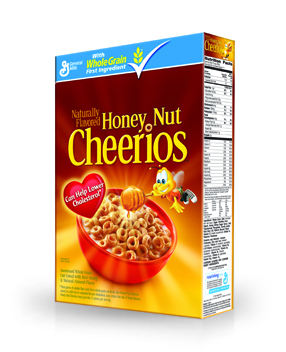
Honey Nut Cheerios: Whole Grain Oats (includes the oat bran), Modified Corn Starch, Honey, Brown Sugar Syrup, Salt, Tripotassium Phosphate, Canola and/or Rice Bran Oil, Natural Almond Flavor, Vitamin E (mixed tocopherols) Added to Preserve Freshness.

Multi Grain Cheerios: Whole Grain Corn, Whole Grain Wheat, Whole Grain Oats, Whole Grain Barley, Whole Grain Rice, Corn Starch, Brown Sugar Syrup, Corn Bran, Salt, Tripotassium Phosphate, Canola and/or Rice Bran Oil, Color Added, Vitamin E (mixed tocopherols) Added to Preserve Freshness.
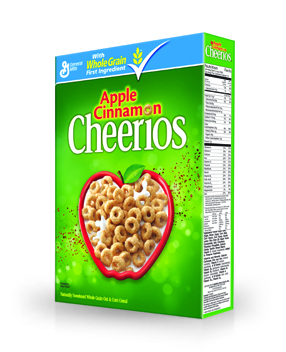
Apple Cinnamon Cheerios: Whole Grain Oats, Sugar, Brown Sugar, Corn Meal, Corn Starch, Corn Syrup, Canola and/or Rice Bran Oil, Apple Puree Concentrate, Salt, Cinnamon, Trisodium Phosphate, Sodium Citrate, Vanillin, Wheat Starch, Vitamin E (mixed tocopherols) Added to Preserve Freshness.

Chocolate Cheerios: Whole Grain Corn, Sugar, Corn Syrup, Cocoa Processed with Alkali, Whole Grain Oats, Canola and/or Rice Bran Oil, Salt, Color Added, Dried Corn Syrup, Corn Bran, Barley Malt Extract, Trisodium Phosphate, Vanillin. Vitamin E (mixed tocopherols) and BHT Added to Preserve Freshness.
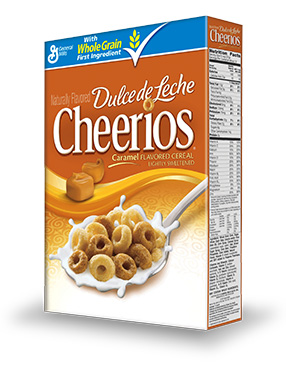
Dulche de Leche Cheerios: Whole Grain Corn, Sugar, Whole Grain Oats, Canola and/or Rice Bran Oil, Corn Syrup, Caramel Syrup (caramelized sugar, water), Salt, Brown Sugar Syrup, Corn Bran, Trisodium Phosphate, Color Added, Natural Flavor, Vitamin E (mixed tocopherols) and BHT Added to Preserve Freshness.
Multi Grain Cheerios Peanut Butter: Whole Grain Corn, Sugar, Peanut Butter (peanuts, monoglycerides), Whole Grain Oats, Whole Grain Sorghum, Whole Grain Barley, Whole Grain Rice, Corn Syrup, Dextrose, Salt, Canola and/or Rice Bran Oil, Peanut Oil, Color Added, Vitamin E (mixed tocopherols) and BHT Added to Preserve Freshness.

Cinnamon Burst Cheerios: Whole Grain Corn, Sugar, Corn Bran, Corn Meal, Soluble Corn Fiber, Canola and/or Rice Bran Oil, Whole Grain Oats, Brown Sugar Syrup, Salt, Cinnamon, Guar Gum, Natural Flavor, Color Added, Vitamin E (mixed tocopherols) and BHT Added to Preserve Freshness.
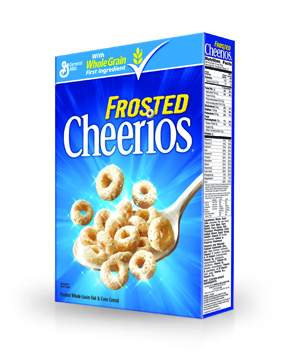
Frosted Cheerios: Whole Grain Oats (includes the oat bran), Sugar, Corn Meal, Corn Starch, Corn Syrup, Salt, Trisodium Phosphate, Color Added, Brown Sugar Syrup, Vanillin, Vitamin E (mixed tocopherols) Added to Preserve Freshnees.

Fruity Cheerios: Whole Grain Corn, Sugar, Whole Grain Oats, Corn Syrup, Canola and/or Rice Bran Oil, Pear Puree Concentrate, Salt, Corn Starch, Dried Corn Syrup, Corn Bran, Trisodium Phosphate, Natural Flavor, Color (red 40, yellow 6, blue 1, and other color added), Sodium Citrate, Vitamin E (mixed tocopherols) BHT and Ascorbic Acid Added to Preserve Freshness.
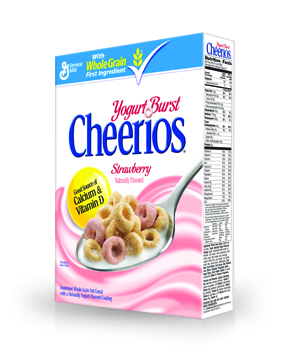
Yogurt Burst Cheerios: Whole Grain Oats (includes the oat bran), Sugar, Naturally Yogurt Flavored Coating (sugar, fractionated palm kernel oil, dextrose, corn starch, dried strawberries, dried nonfat yogurt [heat treated after culturing](cultured nonfat milk), color added, soy lecithin, nonfat milk, natural flavor, maltodextrin), Corn Meal, Modified Corn Starch, Corn Syrup, Salt, Trisodium Phosphate, Brown Sugar Syrup, Color Added, Wheat Flour, Vitamin E (mixed tocopherols) Added to Preserve Freshness.

Banana Nut Cheerios: Whole Grain Corn, Sugar, Whole Grain Oats, Brown Sugar Syrup, Corn Syrup, Canola and/or Rice Bran Oil, Salt, Dried Corn Syrup, Banana Puree, Corn Bran, Corn Starch, Trisodium Phosphate, Color Added, Sodium Citrate, Natural Flavor, Natural Almond Flavor, Vitamin E (mixed tocopherols) and BHT Added to Preserve Freshness.
Once again, all of the bolded ingredients above are likely GMOs.
Analysis
Currently on the Cheerios website, General Mills claims their Cheerios varieties are a part of a healthy diet because they are low in saturated fat, naturally cholesterol free, can help lower cholesterol, are made with whole grains like oats, and provide essential vitamins and minerals.
Over the years public perception has been shaped by these and similar claims so that Cheerios cereals have become widely considered to be a healthy choice that is low in sugar, unprocessed, and made with natural ingredients.
But what is true, and what is fiction? Let's break it down.
Are Cheerios Made with Wholesome Grains and Oats?
Originally called “Cheerioats”, the Cheerios name was selected so the cereal would be associated with the taste and wholesome appeal of oats. One of the main nutrition angles that General Mills exploits is the use of natural oats in Cheerios, however, in seven out of the twelve Cheerios varieties currently sold in the U.S. marketplace, oats are not even listed as the first ingredient (remember, ingredients are listed in order of abundance by weight within a product).
All Cheerios cereal varieties are made with whole grains and do have at least 8 grams per serving, but whole grains ground into flour, do not have the same health benefits as unprocessed whole grains. On the Cheerios website they say that their process is simply mixing, cooking, forming, and toasting. While that sounds nice, the final product – uniform and indistinguishable O’s – bears little resemblance to whole oats or any other whole grains. Cheerios are indeed made with whole grains, but “processed whole grains” would be a more appropriate listing.
Are Cheerios Low in Sugar?
In terms of Sugar - Only Regular Cheerios, Multi Grain Cheerios, and Dulche De Leche Cheerios have less than 9 grams of sugar per serving. The nine other Cheerios varieties have a sugar content that is much too high to be considered low or healthy when compared to other accessible breakfast cereal options. The American Heart Association recommends that women consume no more than 25 grams of added sugar per day, and no more than 38 grams for men. The average amount of sugar per serving (1 or ¾ Cups depending on variety) across all varieties of Cheerios is 7.92 grams per cup or quarter cup.
According to the nutritional information on the Cheerios website, the serving sizes are not consistent across the whole Cheerios line. The serving size is 1 cup for both regular Cheerios, which has 1 gram of sugar serving, and for Multi Grain Cheerios, which has 6 grams of sugar per serving.
Conversely, the more sugary varieties of Cheerios: Honey Nut Cheerios, Apple Cinnamon Cheerios, Banana Nut Cheerios, Chocolate Cheerios, Multi Grain Cheerios Peanut Butter, Fruity Cheerios, and Yogurt Burst Cheerios - have a smaller serving size of ¾ Cup. This is not something that Cheerios advertises as broadly as the other aspects of its cereals, probably because it would draw attention to the fact that even though you are supposed to be eating less of these Cheerios varieties, you are still getting more sugar. Since this is not as widely publicized, then there are almost certainly consumers who are unaware of these different serving sizes and are starting their days off with an even higher amount of unexpected sugar.
Do Cheerios Reduce the Risk of Heart Disease and High Cholesterol?
Cheerios are infamous for their heart healthy claims and for being low in saturated fat and cholesterol. The brand in the past pushed these claims so heavily that in 2009 the FDA had to send a letter asking General Mills to alter Cheerios marketing strategies because of “unauthorized health claims” and because said claims would mean that Cheerios would fall under the label of an “unapproved new drug”. Cheerios has since reworked their marketing and health claims into the message that Cheerios CAN be a part of a healthy diet that COULD reduce the risks of heart disease.
It is important to note that part of what allows Cheerios to claim that it can be part of a diet that could reduce the risk of heart disease is the cereals’ fiber and whole grain content. We already covered the whole grain aspects of Cheerios, and when looking at fiber it appears that ONLY Regular Cheerios, Honey Nut Cheerios, and Yogurt Burst Cheerios contain soluble fiber, with Cheerios having just 1 gram per serving, Honey Nut Cheerios having 0.75 gram per serving, and Yogurt Burst Cheerios with “less than 1 gram of soluble fiber”.
Concerning insoluble fiber, listed on the boxes as dietary fiber – Only Regular Cheerios, Multi Grain Cheerios, Multi-Grain Cheerios Peanut Butter, and Cinnamon Burst have over 2 grams of Dietary Fiber. The remaining 8 out of the 12 varieties are only at an inadequate 2 grams per serving.
The bottom line for this is that if you are eating cereal for breakfast and we were only paying attention to fiber numbers, then regular Cheerios is the only variety of Cheerios that would provide an adequate amount of fiber to start your day in a healthy way.
What about the other ingredients in Cheerios that are not bolded because of a high risk of being GMOs?
BHT is Butylated Hydroxytoluene a food additive used to preserve freshness in some products, but in scientific studies it has been shown to be possible carcinogen. As shown above, BHT is used in Chocolate Cheerios, Dulche De Leche Cheerios, Multi Grain Cheerios Peanut Butter, Cinnamon Burst Cheerios, Fruity Cheerios, and Banana Nut Cheerios.
Other ingredients used in some or all of the Cheerios varieties that have raised red flags for health conscious consumers include: Trisodium Phosphate, Artificial Colors, Natural Flavors, Vanillin (synthetic Vanilla), Corn Syrup, Soy Lecithin, Maltodextrin, and Glycerides. Each of these ingredients have been possibly linked to negative health impacts by studies in recent years and many health conscious consumers have put these ingredients on their do-not-eat lists.
Do Cheerios Contain GMOs?
The most common GMO crops to look out for in the U.S. are Soy, Corn, Cotton, Canola, Sugar Beets, and Papaya. Foods that clearly have these words in their ingredient lists are all at risk of being GMO if they are not certified organic or Non-GMO.
General Mills sources its corn from the United States, where 88% of the crop is genetically modified, and our ingredient breakdown showed that corn-based ingredients are a common ingredient in all Cheerios varieties. While the corn ingredients are easy to spot and flag, some other high GMO risk ingredients that have been bolded are a little more inconspicuous. For example, Vitamin E is in each and every one of the Cheerios products, and is a hidden GMO ingredient that many consumers are unaware of. Vitamin E in Cheerios comes from Mixed Tocopherols which are most commonly derived from soy, corn, or cotton –the most extensively genetically engineered crops. For a list of other GMO ingredients that are commonly hidden in processes foods, Non-GMO Shopping Guide has built this highly useful list.
As a refresher, If you were to sample each and every Cheerios product –since General Mills does not make organic Cheerios or allow GMO testing – the following are the likely GMOs you would be consuming: Modified Corn Starch, Sugar, Vitamin E (mixed tocopherols), Honey, Brown Sugar Syrup, Canola Oil, Natural Almond Flavor, Whole Grain Corn, Corn Starch, Corn Bran, Corn Syrup, Dried Corn Syrup, Caramel Syrup made from Caramelized Sugar, Natual Flavors, Peanut Butter made with Monoglycerides, Dextrose, Corn Meal, Soluble Corn Fiber, Sodium Citrate, Ascorbic Acid, Soy Lecithin, Maltodextrin.
Multi Grain Cheerios are the only Cheerios variety that has just one likely GMO ingredient in its first three ingredients listed. The likely GMO ingredient however is its first-listed and most abundant ingredient: Whole Grain Corn. This Whole Grain Corn is almost certainly genetically modified.
Besides Multi Grain Cheerios, the ingredients list for every single other variety of Cheerios starts with at least two out of its most abundant ingredients as likely GMOs. Taking this a step further – each of the first three ingredients for both Chocolate and Multi Grain Cheerios Peanut Butter are likely GMOs, and all of the first six ingredients in Cinnamon Burst Cheerios are very likely to be made from GMOs.
Conclusions
Cheerios of all types are loaded with likely GMOs, and the brand across the board does not live up to the positive public perception and nutritious message that General Mills has cultivated through years of advertisements, loose health claims, and public relations strategies.
For people interested in eating for optimal health, consuming whole foods and staying away from processed products are good basic guidelines to follow. The lengthiness of the Cheerios ingredient lists and the inclusion of unrecognizable synthetic ingredients, unnecessary and controversial food additives, cheap sweeteners, and unwholesome ingredients are directly inconsistent with those basic health rules. After reading the labels, it should be clear that there are definitely safer and less processed sources for your breakfast fiber, vitamins, and whole grains.
What Can We Do?
If you are an individual concerned about the risks of GMOs and the health of your families and the environment, GMO Inside invites you to reach out to General Mills through our petition and let Cheerios know what you think of their use of GMOs on their Facebook Page.
If you have any questions about GMOs or comments about how some of these ingredients are at high risk of being a GMO, please leave a comment below!

|
|
Chipotle Cooks Up Something New: GMO Labeling |
Originally published by Natural News
Thursday, June 13, 2013
by: Jonathan Benson
Source article
(NaturalNews) The recent decision by Whole Foods Market to label all genetically-modified organisms (GMOs) sold in its stores by the long-off date of 2018 looks silly and almost meaningless compared to the right-now policy of fresh food chain Chipotle, which is officially the first and only major U.S. food supplier to voluntarily incorporate GMO labeling. On its "Ingredients Statement" website, Chipotle clearly outlines which of its food products contain GMOs, and also states that it is working aggressively to source completely non-GMO ingredients for all of its products as it moves forward.
Chipotle has always marketed itself as a healthy alternative to fast food, having taken steps from the beginning to eliminate things like dairy products produced using the artificial growth hormone rBST, for instance, and replacing them with pasture-raised dairy products. Chipotle has also played a key role in propelling forward the local agriculture movement by sourcing as many locally-grown and organic ingredients as possible, and eliminating artificial additives and other toxins commonly used in fast food. Chipotle's latest success: GMO labeling.
But now Chipotle has set the bar even higher, and by choice, delineating each and every ingredient used in its meats, beans, rice, and dressings, and clarifying which ones contain GMOs. The primary GMO offender, as you will notice on Chipotle's "Ingredients Statement" page, is soybean oil, which is reluctantly used in several of the chain's meat and rice products. In fact, this commercial frying and cooking oil appears to be one of the only, if not the only, GMO ingredient still used by Chipotle.
"Our goal is to eliminate GMOs from Chipotle's ingredients, and we're working hard to meet this challenge," explains the page. "For example, we recently switched our fryers from soybean oil to sunflower oil. Soybean oil is almost always made from genetically modified soybeans, while there is no commercially available GMO sunflower oil. Where our food contains currently unavoidable GM ingredients, it is only in the form of corn or soy."
You can view the Chipotle "Ingredients Statement" page at the following link. Note that all items containing a "G" in the pink box contain GMOs:
http://www.chipotle.com
Whole Foods' track record on GMOs an embarrassment to the health freedom movement
While much of what Chipotle sells still admittedly contains GMOs in the form of corn and soybean oil, the company's willingness to be forthcoming with its customers and the public about this fact is highly commendable. And it is a lot more than we can say for Whole Foods Market, which is still not being completely honest with its customers. The fact that Chipotle is already voluntarily labeling GMOs, and clearly indicating its intent to continue phasing them out right now, shows that Whole Foods' 2018 labeling deadline is more of a political move to save face than a practical move to actually get the job done.
Other health food retailers like Trader Joe's have already phased GMOs out of their private label brands (http://www.traderjoes.com/about/customer-updates-responses.asp?i=4), while health food stores like Natural Grocers source only organic produce and require that their packaged food suppliers fully disclose the source of any potential GMO ingredients. Natural Grocers even states directly on its website that, as a company, it does not consider GMOs to be at all safe for human consumption (http://www.naturalgrocers.com).
But Whole Foods, despite being a prominent leader in health food industry, has long taken the most ambiguous stance on GMOs. Besides its recent GMO labeling announcement and adoption of Non-GMO Project labeling back in 2009, both of which are commendable in their own rite, Whole Foods has not been nearly as forthcoming with its customers about GMOs, and yet continues to charge a premium for its products. While eventual labeling in 2018 may still be a positive step forward, it clearly lacks the proactive approach already being taken by companies like Chipotle.
|
|
3 Tips for Avoiding GMOs |
Without GMO labeling requirements in the US it can be very difficult to know if you are eating GMOs. Luckily, there are some tricks if you want to avoid GMOs in your diet and support a more sustainable food supply.
Here's how!
1. Choose Organic
Buying 100% Organic, Certified Organic, and USDA Organic-labeled products is usually the easiest way to avoid genetically modified ingredients. Plus organic farming does not allow for non-organic pesticides to be used on crops so its better for our eco-systems and the farmers growing our food.
The U.S. and Canadian governments do not allow companies to label products "100% Organic" or Certified Organic if they contain GMOs.
2. Choose Non-GMO Verified Products
The Non-GMO Project seal indicates that a product has gone through the Non-GMO Project's verification process to ensure that any potential genetically modified ingredients are tested and non-GMO. (This includes ingredients that are currently being genetically modified and commercially available such as corn, soy and sugar beets.
3. Avoid potential GMO Ingredients altogether
There are currently 9 crops in the US that have been approved to be genetically modified: Alfalfa, Canola, Corn , Cotton, Papaya, Soy, Sugar Beets, Zucchini and Yellow Summer Squash. By avoiding these foods and ingredients altogether you can avoid GMOs. However it can be very tricky since over 85% of processed foods in the grocery store contain one or more of these ingredients, often disguised in other names such as corn syrup, maltodextrin, or lecithin.
Understanding the Details:
To recognize Organic and Non-GMO foods more easily, it's helpful to review the various organic and non-GMO labels and the current labeling requirements in the U.S. and Canada.

1. 100% Organic: Must contain 100% organically produced ingredients (excluding water and salt). This is the only label that certifies a completely organic product AND is also completely non-GMO.
2. Certified Organic / USDA Organic / Organic: At least 95% of content is organic by weight (excluding water and salt). The <5% remaining ingredients must consist of substances approved on the USDA’s NOSB National List. GMOs are NOT on this list, so these products are also non-GMO.
3. Made with Organic: Up to 70% of the ingredients are organic. These products can NOT carry a “USDA organic” label and may possibly contain GMO ingredients.

4. Non-GMO Verified: The verification seal indicates that the product bearing the seal has gone through the Non-GMO Project's verification process. Any GMO ingredient being grown commercially must be tested prior to use in a verified product. The Non-GMO Project has an Action Threshold of 0.9% and is in alignment with laws in the EU, where any product containing more than 0.9% GMO must be labeled. This DOES NOT mean that the crop ingredients have been grown without harmful pesticides, insecticides or chemical fertilizers it simply means that the ingredients are non-GMO.
5. GMO Ingredients: If a product contains any potential GMO ingredients (or derivatives of these ingredients) that are not organic or Non-GMO Project verified, its likely these ingredients could be genetically modified. GMO Ingredients to look out for in teh US include corn, soy, canola, cotton, sugar beets, zucchini, yellow squash, papaya and alfalfa.
What are your favorite tips for avoiding GMOs? Please let us know in the comment section!
|
|
Rejecting GMO Foods? Check Your Baby Formula |

As a parent, we're sure you've considered which brands will have the best infant formula for your newborn. But have you ever thought about GMOs? If you prioritize avoiding GMO foods in your diet, what about your baby?
In May 2013, GMO Inside called on the three largest US infant formula manufacturers to remove their GMO ingredients. Beyond obstructing the consumer's right to know what they are eating (by not labeling their GM ingredients) and contributing to the increasing corporate control of our food system, GMOs pose particular health risks to infants. We asked our friend and ally - Dr. Michelle Perro - a California based pediatrician to break down for us why GMO ingredients are particularly risky for babies.
Guest Post by Michelle Perro, M.D.
For the infant that is unable to nurse, formula is the next best choice. But whether to use a home-prepared formula or a commercial brand depends on many factors. For my patients, I usually recommend a commercial brand. While there are several formulas to choose from, there are certain 'musts' that I do insist upon--first and foremost, the formula should be organic. Because of the toxic effects of herbicides, particularly glyphosate (due to its prolific usage) as well as other organophosphates and genetically engineered foods [in non-organic commercial formulas], these are not an option for infant feeding.
Glyphosate, the active ingredient in Roundup, the inert ingredients in Roundup, as well as Roundup ready seeds (which do not perish under increased spraying of the herbicide) have been shown clearly to have profound toxicity on health. One particular issue is that it eliminates beneficial bacteria [in our intestines]. More pathologic bacteria that can reside in our intestines have been shown to be resistant to its effects and can thrive. The beneficial bacterial play a key role in many important functions in the body, particularly immune function. In addition, glyphosate inhibits the activity of a group of enzymes ubiquitous in the body called cytochrome P450 enzymes which are important for oxidation and well as detoxification in the liver. [Read more about the studies linking health effects of Roundup here.]
Full maturity of the liver in the infant takes approximately two years. As soon as the umbilical cord is cut, rapid induction of liver functions begin. The infant liver is delayed in achieving normal detoxifying and synthetic functions such as making proteins, coagulation factors, breaking down products from hemoglobin synthesis (bilirubin being one and, hence, the development of neonatal jaundice), etc. If you expose newborns to substances that further impair liver and immune function, the infant has increased health risks.
Lets look at Similac, for example:
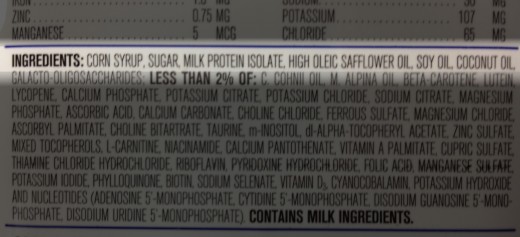
You will note that the number one and two ingredients are corn syrup and sugar. Both of these products are highly genetically modified, so unless you stick to organic, your infant will be eating pesticide-laden, GMO processed food.
Why not GMOs? There is an alarming rate of childhood disorders now including allergies, autoimmunity, neurological disorders (Autism and ADHD), growth failure, endocrine disruption, etc. There are modifications to the immune function that can take place prenatally and early in life which leads to the above disorders ("developmental immunotoxicity"). Increased exposure to environmental toxins during those sensitive times may contribute to the health conditions noted above. In animal studies where they were fed GMOs, there were profound changes in their intestines as well as immune function. There is likely synergistic toxicity. If there is an insult to the intestine whether it be in its structure or normal bacterial biome, a negative health cycle can begin.
From this pediatrician's perspective, I do believe we can successfully feed our babies with organic foods. I like to add additional organic probiotics (bifidus) to the formula. In order to ensure the health of our infants and children, there is no amount of acceptable herbicide or GMO that should be in their diets.
***
Want to share this post with other doctors or parents? Download our PDF version here to print.
Looking for other alternatives if you are not able to breast feed? Check out our list of resources for donor milk banks and non-GMO homemade recipes.
GMO Inside would like to express enormous gratitude to Dr. Perro for her contributions to this post and the GMO Inside campaign.
To take action, please sign our petition to Similac, Enfamil and Nestle, and learn more about infant formulas and the GMO ingredients that may be hiding inside these foods and more at GreenAmerica.org/gmo-inside!
|
|
A Girl Scout Speaks Up for Non-GMO Girl Scout Cookies |

Alicia, a Girl Scout, is leading the charge for non-GMO Girl Scout cookies
“Please take the GMOs out of the cookies, because they are not natural for our bodies, and I bet Australia doesn't want them, or Texas, or Santa Ana or anywhere. And, because if we don't know that they're safe, we don't want them in our food.”
You might not expect it, but this compelling statement comes from 6-year-old Girl Scout, Alicia Serratos. Alicia recently started the Change.org petition, “Girl Scouts: Please make cookies without GMOs,” that has over 8,000 supporters so far, and urges the Girl Scouts to see the dangers of GMOs and to make a positive change in their cookie recipes.
Selling upwards of 200 million boxes of cookies every year, the Girl Scouts could have a huge impact on the availability of non-GMO foods and ingredients, and Alicia is spreading the word to get us there.
We recently interviewed Alicia about her activism:
Green America (GA): Why do you think it’s important to get GMOs out of the Girl Scout cookies?
Alicia: Because they are dangerous. They make bugs’ tummies explode, and the rats get tumors. GMOs are not natural. I don't want my family to eat them, or my friends, or the whole world.
GA: How do you tell other people about this?
A: On the computer. By sending emails, posting it on Change.org, on my Facebook, and I can tweet it. And we pass out fliers [about] GMOs and that they're not safe and not natural for our bodies.
GA: Do you think there are other girls across the country who also want non-GMO Girl Scout cookies?
A: Yes, like in America, New York, Colorado, Australia, Florida, and Louisiana. I think I'm helping everyone in the world and I think I’m doing the right thing.
We think she’s doing the right thing too. There are an increasing number of studies linking GMOs and the chemicals they are sprayed with to food allergies and auto-immune diseases. These health concerns, along with the damage that GMOs cause for the environment and farmers (both here and abroad), should be reasons enough to make the switch to non-GMO cookies. Millions of Americans enjoy Girl Scouts’ cookies every year, but we agree with Alicia from Troop #2753 – we deserve cookies that we know for certain are safe for humans and the environment.
Please help Alicia and sign her Change.org petition here: http://www.change.org/petitions/girl-scouts-please-make-cookies-without-gmos.
And visit the Girl Scouts’ Facebook page to tell them that you love their cookies, but that next cookie season, you want ones that are free of GMOs: https://www.facebook.com/GirlScoutsUSA.
For updates on Alicia and her non-GMO quest, you can visit her blog: http://rickyrosie.wordpress.com/.
Green America is dedicated to educating consumers and businesses about the impacts of genetic engineering and genetically modified organisms (GMOs), shifting corporations away from a reliance on toxic herbicides and GMOs towards organic and regenerative farming practices. Learn more about our efforts against genetic engineering.
|
|
Are GMOs Good or Bad? 10 Reasons to Ditch GM Foods |
Originally published by Nation of Change
by GM Watch
March 19, 2013
The time has come to choose between a GM based, or a non GM-based, world food supply.
Genetically modified (GM) foods are often promoted as a way to feed the world, leaving people wondering if GMOs are good or bad. But this is little short of a confidence trick. Far from needing more GM foods, there are urgent reasons why we need to ban them altogether.
1. GM foods won’t solve the food crisis
A 2008 World Bank report concluded that increased biofuel production is the major cause of the increase in food prices. Biofuels are crops grown for fuel rather than food. GM giant Monsanto has been at the heart of the lobbying for biofuels — while profiting enormously from the resulting food crisis and using it as a PR opportunity to promote GM foods!
“The climate crisis was used to boost biofuels, helping to create the food crisis; and now the food crisis is being used to revive the fortunes of the GM industry.” — Daniel Howden, Africa correspondent, The Independent (UK)
“The cynic in me thinks that they’re just using the current food crisis and the fuel crisis as a springboard to push GM crops back on to the public agenda. I understand why they’re doing it, but the danger is that if they’re making these claims about GM crops solving the problem of drought or feeding the world, that’s bullshit.” – Prof Denis Murphy, head of biotechnology, University of Glamorgan, Wales
2. GM crops do not increase yield potential
Despite the promises, GM has not increased the yield potential of any commercialised crops. In fact, studies show that the most widely grown GM crop, GM soya, has suffered reduced yields.
A report that analyzed nearly two decades worth of peer reviewed research on the yield of the primary GM food/feed crops, soybeans and corn (maize), reveals that despite 20 years of research and 13 years of commercialization, genetic engineering has failed to significantly increase US crop yields. The author, former US EPA and US FDA biotech specialist Dr Gurian-Sherman, concludes that when it comes to yield, “Traditional breeding outperforms genetic engineering hands down.”
“Let’s be clear. As of this year [2008], there are no commercialized GM crops that inherently increase yield. Similarly, there are no GM crops on the market that were engineered to resist drought, reduce fertilizer pollution or save soil. Not one.” – Dr Doug Gurian-Sherman
3. GM crops increase pesticide use
US government data shows that in the US, GM crops have produced an overall increase, not decrease, in pesticide use compared to conventional crops.
“The promise was that you could use less chemicals and produce a greater yield. But let me tell you none of this is true.” – Bill Christison, President of the US National Family Farm Coalition
4. There are better ways to feed the world
A major UN/World Bank-sponsored report compiled by 400 scientists and endorsed by 58 countries concluded that GM crops have little to offer global agriculture and the challenges of poverty, hunger, and climate change, because better alternatives are available. In particular, the report championed “agroecological” farming as the sustainable way forward for developing countries.
5. Other farm technologies are more successful
Integrated Pest Management and other innovative low-input or organic methods of controlling pests and boosting yields have proven highly effective, particularly in the developing world. Other plant breeding technologies, such as Marker Assisted Selection (non-GM genetic mapping), are widely expected to boost global agricultural productivity more effectively and safely than GM.
“The quiet revolution is happening in gene mapping, helping us understand crops better. That is up and running and could have a far greater impact on agriculture [than GM].” – Prof John Snape, head of the department of crop genetics, John Innes Centre
6. GM foods have not been shown to be safe to eat
Genetic modification is a crude and imprecise way of incorporating foreign genetic material (e.g. from viruses, bacteria) into crops, with unpredictable consequences. The resulting GM foods have undergone little rigorous and no long-term safety testing. However, animal feeding tests have shown that GM foods have toxic effects, including abnormal changes in organs, immune system disturbances, accelerated ageing, and changes in gene expression. Very few studies have been published on the direct effects on humans of eating a GM food. One such study found unexpected effects on gut bacteria, but was never followed up.
It is claimed that Americans have eaten GM foods for years with no ill effects. But these foods are unlabeled in the US and no one has monitored the consequences. With other novel foods like trans fats, it has taken decades to realize that they have caused millions of premature deaths.
“We are confronted with the most powerful technology the world has ever known, and it is being rapidly deployed with almost no thought whatsoever to its consequences.” — Dr Suzanne Wuerthele, US Environmental Protection Agency (EPA) toxicologist
7. People don't want GM foods – so they're hidden in animal feed
As a spokesperson for Asgrow, a subsidiary of Monsanto, said, "If you put a label on genetically engineered food, you might as well put a skull and crossbones on it." The GM industry has got around the problem of consumer rejection of GM foods by hiding them in animal feed. Meat, eggs and dairy products from animals raised on the millions of tons of GM feed imported into Europe do not have to be labelled. Some studies show that contrary to GM and food industry claims, animals raised on GM feed ARE different from those raised on non-GM feed. Other studies show that if GM crops are fed to animals, GM material can appear in the resulting products and affect the animals’ health. So eating these “stealth GMOs” may affect the health of consumers.
8. GM crops are a long-term economic disaster for farmers
A 2009 report showed that GM seed prices in America have increased dramatically, compared to non-GM and organic seeds, cutting average farm incomes for US farmers growing GM crops. The report concluded, “At the present time there is a massive disconnect between the sometimes lofty rhetoric from those championing biotechnology as the proven path toward global food security and what is actually happening on farms in the US that have grown dependent on GM seeds and are now dealing with the consequences.”
9. GM and non-GM cannot co-exist
GM contamination of conventional and organic food is increasing. An unapproved GM rice that was grown for only one year in field trials was found to have extensively contaminated the US rice supply and seed stocks. In Canada, the organic oilseed rape industry has been destroyed by contamination from GM rape. In Spain, a study found that GM maize “has caused a drastic reduction in organic cultivations of this grain and is making their coexistence practically impossible”.
The time has come to choose between a GM-based, or a non-GM-based, world food supply.
“If some people are allowed to choose to grow, sell and consume GM foods, soon nobody will be able to choose food, or a biosphere, free of GM. It’s a one way choice, like the introduction of rabbits or cane toads to Australia; once it’s made, it can’t be reversed.” – Roger Levett, specialist in sustainable development
10. We can’t trust GM companies
The big biotech firms pushing their GM foods have a terrible history of toxic contamination and public deception. GM is attractive to them because it gives them patents that allow monopoly control over the world’s food supply. They have taken to harassing and intimidating farmers for the “crime” of saving patented seed or “stealing” patented genes — even if those genes got into the farmer’s fields through accidental contamination by wind or insects.
“Farmers are being sued for having GMOs on their property that they did not buy, do not want, will not use and cannot sell.” – Tom Wiley, North Dakota farmer
See the source article and all its wonderful resources here
Read more GMO Inside News »
|
|
Coca-Cola Responds to Demands for Change |
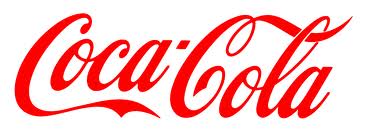
Last week we received a response from Coca-Cola about our petition to Coke and Pepsi asking for GMO labeling and/or the removal of GMO ingredients from their products.
We wanted to share Coke's response letter (below), since more than 4,000 of you have already taken action with us, and we wanted to share with you our latest reply to Coke:
Dear Coca-Cola,
While we do appreciate you getting back to us, (truly we do, we have haven't heard a word from Pepsi) we do not agree with your stance on GMOs or your views on labeling.
Coke Says: "California voters made the right decision in defeating Proposition #37, a poorly written measure that would've been costly and caused confusion about the safety of products labeled."
GMO Inside says: Regardless of the "safety" debate, we believe consumers have a right to know what they are putting in their bodies, and therefore have a right to know if the ingredients in their food have been genetically modified. GMOs have never been proven safe for consumption, and a growing body of studies is raising concerns around the health effects of eating them and their negative environmental impacts. (See Earth Open Source's summary on some of the health concerns)
Coke Says: Because we sell our products nationwide, we oppose state-specific regulations which oppose unreasonable burdens on the food and beverage industry.
GMO Inside says: Ingredient labeling is not an unreasonable burden on the food and beverage industry--it's a rule consumers have come to expect of any product they purchase with plans to ingest. But, if you want to play that card, we'd like to point out that labeling GMO ingredients will will create minimal costs and that the Coca-Cola corporation earned no less than $48 billion in revenues last year.
Major food companies change their packaging all the time, for reasons relating to changing ingredients to seasonal promotions. We aren't demanding that this change happen overnight, but that the labeling of GMOs in the ingredient lists on Coke's products be added to the queue for the next run of packaging. GMO labeling has not increased the costs of food in Europe, according to the former European Commissioner for Health and Consumer Protection, and an Emory Study found that GMO labeling would not increase food prices in the US either.
Coca-Cola, you have the opportunity to be a leader amongst major beverage companies by being the first to end your use of GMOs and let the public know you have done so. Please take this important step for human and environmental health!
Sincerely,
GMO Inside
Sign our petition to Coke and Pepsi>>
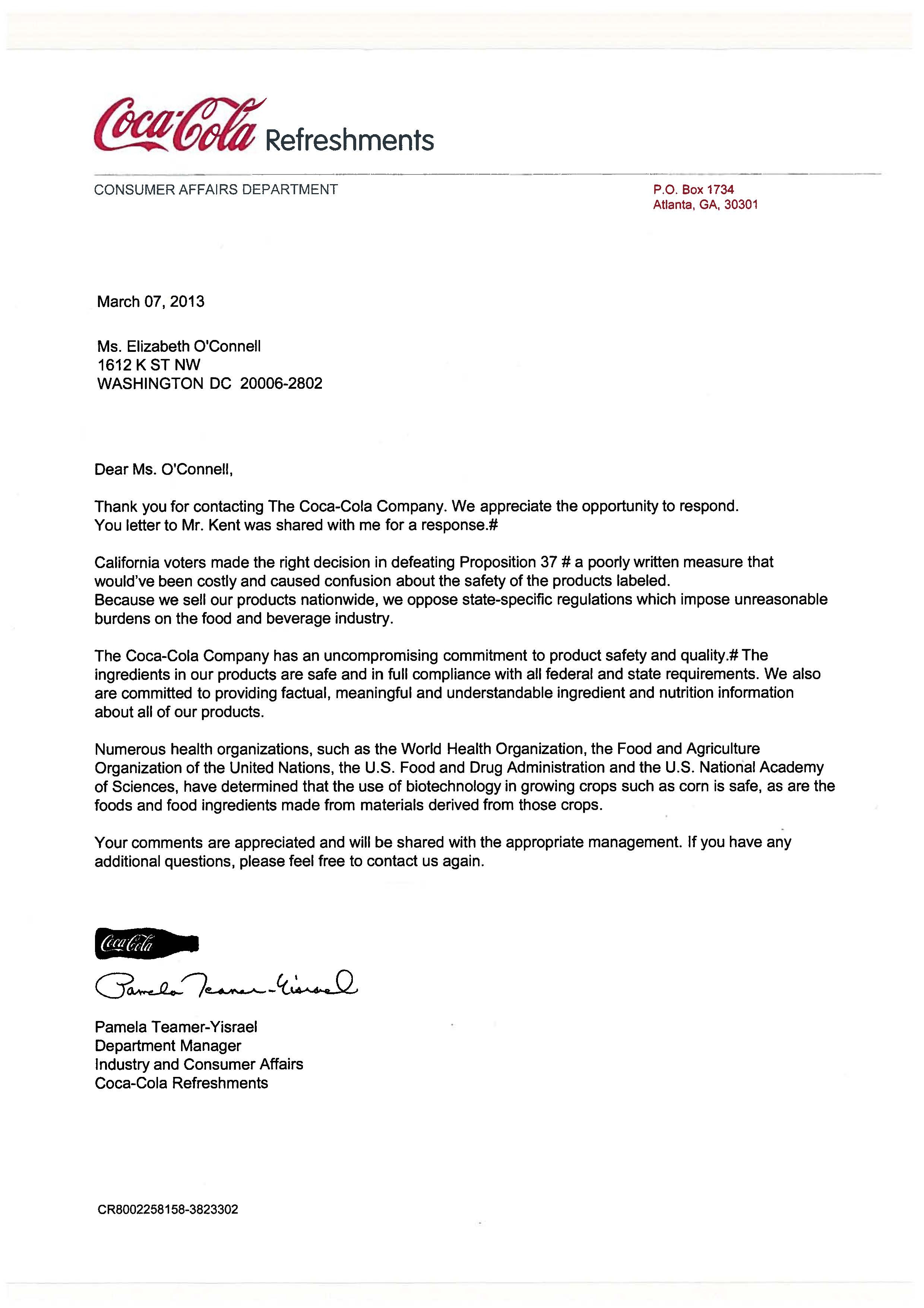
|
|
GMO Timeline: A History of Genetically Modified Foods |
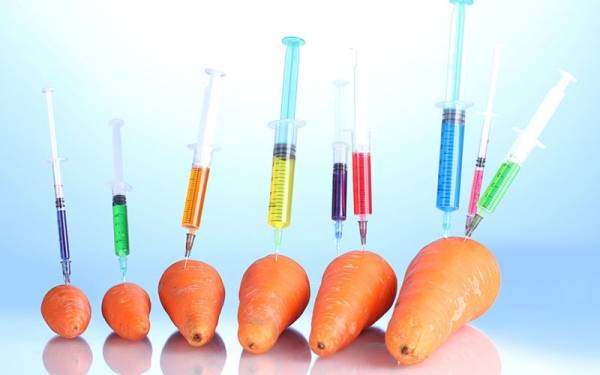
GMO has been a slowly creeping threat for a while, but it’s ramped up lately. (Rosebud Magazine)
Originally published by Rosebud
by GL Woolsey
September 13, 2012
Source article
GMO foods are such an embedded part of our food system these days, but it's not difficult to think back to a time when food was simpler and healthier. How did we get to the point that genetically modified organisms infiltrate so much of what we eat? In a recent issue of Rosebud Magazine, GMO expert GL Woolsey took a look at the history of GMOs. We present that for you here now.
1935 - DNA Discovered
Russian scientist Andrei Nikolaevitch Belozersky isolates pure DNA.
1973 - Recombinant DNA Created
The idea for man-made DNA, or rDNA, comes from a grad student at Stanford University Medical School. Professor Herbert Boyer and a few of his biologist colleagues run with it.
1975 - Asilomar Conference
A group of biologists get together with a few lawyers and doctors to create guidelines for the safe use of genetically engineered DNA.
1980 - First GMO Patent Issued
A 1980 court case between a genetics engineer at General Electric and the U.S. Patent Office is settled by a 5-to-4 Supreme Court ruling, allowing for the first patent on a living organism. The GMO in question is a bacterium with an appetite for crude oil, ready to gobble up spills.
1982 - FDA Approves First GMO
Humulin, insulin produced by genetically engineered E. coli bacteria, appears on the market.
1994 - GMO Hits Grocery Stores
The U.S. Food and Drug Administration approves the Flavr Savr tomato for sale on grocery store shelves. The delayed-ripening tomato has a longer shelf life than conventional tomatoes.
1996 - GMO-Resistant Weeds
Weeds resistant to glyphosate, the herbicide used with many GMO crops, are detected in Australia. Research shows that the super weeds are seven to 11 times more resistant to glyphosate than the standard susceptible population.
1997 - Mandatory Labels
The European Union rules in favor of mandatory labeling on all GMO food products, including animal feed.
1999 - GMO Food Crops Dominate
Over 100 million acres worldwide are planted with genetically engineered seeds. The marketplace begins embracing GMO technology at an alarming rate.
2003 - GMO-Resistant Pests
In 2003, a Bt-toxin-resistant caterpillar-cum-moth, Helicoverpa zea, is found feasting on GMO Bt cotton crops in the southern United States. In less than a decade, the bugs have adapted to the genetically engineered toxin produced by the modified plants.
2011 - Bt Toxin in Humans
Research in eastern Quebec finds Bt toxins in the blood of pregnant women and shows evidence that the toxin is passed to fetuses.
2012 - Farmer Wins Court Battle
French farmer Paul Francois sues Monsanto for chemical poisoning he claims was caused by its pesticide Lasso, part of the Roundup Ready line of products. Francois wins and sets a new precedent for future cases.
2014 - GMO Patent Expires
Monsanto’s patent on the Roundup Ready line of genetically engineered seeds will end in two years. In 2009, Monsanto introduced Roundup 2 with a new patent set to make the first-generation seed obsolete.
|
|
The Boom of GM Farming |
Originally published by Mother Jones
By Jaeah Lee
February 26, 2013
Source article
Despite persisting concerns over genetically modified crops, a new industry report (PDF) shows that GM farming is taking off around the world. In 2012, GMO crops grew on about 420 million acres of land in 28 countries worldwide, a record high according to the International Service for the Acquisition of Agri-biotech Applications, an industry trade group.
If all the world's GMO crop fields in 2012 were sown together, it would blanket almost all of Alaska. As the chart from the report shows, globally GM farming has been on an uninterrupted upward trend. What's especially noteworthy is the growth of GMO farming area in developing nations (see red line), which surpassed that in industrial nations for the first time in 2012. The ISAAA's report doesn't project into the future, but we may see this upward trend continue as "a considerable quantity and variety" of GMO products may be commercialized in developing countries within the next five years, according to a recent UN Food and Agriculture Organisation forum (PDF).
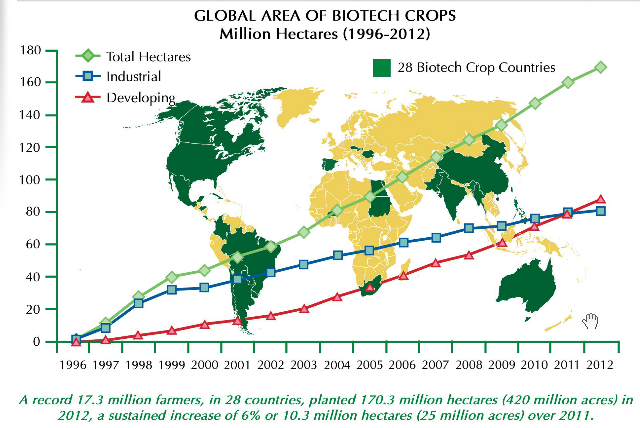
Clive James/ISAAA
The ISAAA says the area of land devoted to genetically modified crops has ballooned by 100 times since farmers first started growing the crop commercially in 1996. Over the past 17 years, millions of farmers in 28 countries have planted and replanted GMO crop seeds on a cumulative 3.7 billion acres of land—an area 50 percent larger than the total land mass of the United States, the group adds.
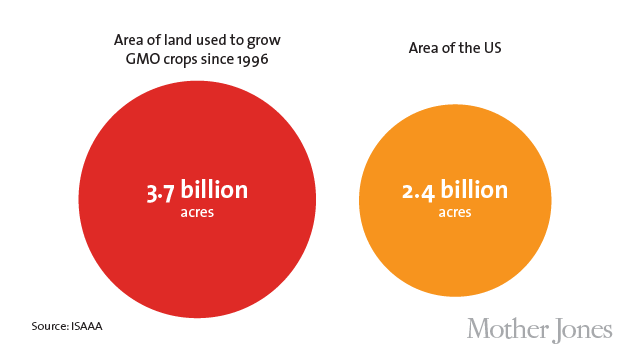
"This makes biotech crops the fastest adopted crop technology in recent history," ISAAA chair Clive James states in the report. "The reason—it delivers benefits."
What kinds of benefits? According to the ISAAA, GM farming has reduced use of pesticides, saved on fossil fuels, decreased carbon dioxide emissions, and "made a significant contribution to the income of < 15 million small resource-poor farmers" in developing countries. These small-scale farmers now make up over 90 percent of all farmers growing GMO crops, the group states.
But just looking at the United States—consistently the biggest GMO crop producer in the world by a long shot—there is much reason to doubt on some of ISAAA's claimed benefits. (More after the chart.)
As my colleague Tom Philpott reported earlier this month, nearly half of all US farms now have superweeds that can resist Monsanto's herbicide Roundup, which is sprayed on crops engineered by Monsanto. A 2012 study by Washington State University showed that overall, GMOs lead to a net increase in pesticide inputs. And a Department of Agriculture-funded paper out this month found that genetically modified doesn't necessarily mean higher crop yields (PDF), one of GMOs' biggest selling points.
There's been some doubt about the wisdom of GMOs in the rest of the world, too. The UN Food and Agriculture Organisation has pointed out (PDF) some of the downsides of GMOs for small farmers and consumers, such as pest resistance, contamination of non-GMO crops, and potential toxicity of GM foods and products. According to the FAO, in 2011, 161 countries ratified the Cartagena Protocol on Biosafety, an international agreement designed to ensure the safe transfer and handling of GMO crops "that may have adverse effects on the conservation and sustainable use of biological diversity, taking also into account risks to human health, and specifically focusing on transboundary movements."
"For peasant farmers, GMOs represent looting and control."
Back in January, more than 60,000 Mexican small-scale farmers marched through Mexico City in protest against Monsanto, Latin American news site Voxxi reported. The company has been trying to obtain unrestricted permission to plant its genetically modified corn in the country. The farmers fear that widespread planting of the modified corn will contaminate native breeds. "For peasant farmers, GMOs represent looting and control," Olegario Carrillo, president of the Mexican small farm organization UNORCA said at the protest.
As the FAO notes, in most cases these GM technologies are proprietary, developed by the private sector and released for commercial production through licensing agreements. Adoption of GM technologies has also spurred a range of social and ethical concerns about restricting access to genetic resources and new technologies, loss of traditions (such as saving seeds), private-sector monopoly, and loss of income of resource-poor farmers. There's also reason to worry about legal battles. Last week the Supreme Court heard oral arguments in a 2007 case Monsanto filed a against Vernon Hugh Bowman, a 75-year-old Indiana farmer. Bowman, Monsanto claims, violated the corporation's patent rights by buying and planting second-generation Roundup Ready seeds, which Monsanto contractually forbids. (Mother Jones' Maggie Severns has more on this here.)
Nonetheless, by ISAAA's count, developing countries show no signs of slowing their adoption GMO crop technologies. In 2012 they surpassed industrial countries in their share of the world's GMO crops, the group reports.
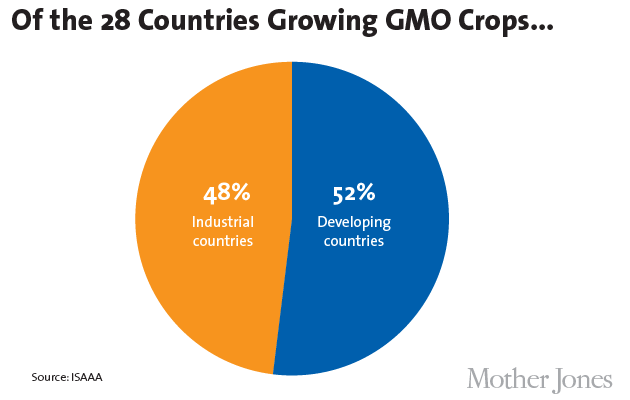
Read more GMO Inside News »
|
|
RECIPE: Non-GMO, Organic Do-si-dos |

For today's installment of homemade Girl Scout cookie recipes we'll be sharing how you can make your own Non-GMO, organic Do-si-dos cookies.
GMO Inside has been calling on the Girl Scouts to remove GMO ingredients from their cookies. Until then, we’re inviting you make a donation to support the Girl Scouts (in the same amount you would have spent on cookies this year) and to bake your own so you can be sure of what you are eating and feeding your family, when it comes to GMOs.
You can join us in sending this message to the Girl Scouts of America by posting a supportive comment on their Facebook wall.
Homemade Organic Do-si-dos Cookies
Recipe adapted by GMO Inside's resident organic baker.
Makes about 48 sandwich cookies.
Preparations: Preheat oven to 350F.
SANDWICH
- 2 1/4 cups all purpose organic flour
- 2 tbsp baking soda
- 1 tbsp baking powder
- 1/2 tsp sea salt
- 1 1/2 cups unsalted organic butter, room temperature
- 3/4 cup chunky organic peanut butter
- 1 cup organic brown sugar
- 1 cup organic sugar
- 3 large organic eggs
- 1 tsp vanilla extract
- 1 1/2 cups quick-cooking organic oats (not instant or regular)
FILLING
- 1 1/2 cups creamy organic peanut butter, room temperature
- 1/2 cup organic butter, room temperature
- 1/4 cup organic confectioners’ sugar
Start with the cookies. In a medium bowl, whisk together the flour, baking powder, baking soda and salt.
In a large bowl, cream together butter and peanut butter. Beat in the sugars until fluffy, then add in the eggs one at a time, waiting until each is fully incorporated before adding the next. Stir in vanilla extract.
Working at a low speed, mix in the flour, followed by the oats (if you don’t have quick-cooking, pulse whole rolled oats in the food processor to chop them up a bit).
On a parchment-lined baking sheet, drop teaspoonfuls of batter (roughly 3/4-in. sized balls), leaving about 2 inches between each to allow for spread.
Bake for about 10 minutes, until cookies are a light golden brown. Cool on baking sheet for 5 minutes, making small holes in 1/2 of the cookies (for the tops of the sandwiches) before they set up. Transfer to a wire rack to cool completely.
Once cookies have cooled, make the filling.
In a large bowl, cream together smooth peanut butter, butter and confectioners’ sugar until very smooth. Spread 2-3 tsp onto half of the finished cookies and sandwich with the remaining halves. If you chose to make yours with Girls Scout lookalike holes in some of the cookies, use these as the tops of the sandwiches.
Store in an airtight container.
|
|
Why are we Eating Foods that are Banned in Europe? Food Babe Investigates. |
Guest post by Vani Hari (a.k.a. The Food Babe)
Vani is a member of the GMO Inside Steering Committee and a regular contributor on 100 Days of Real Food.
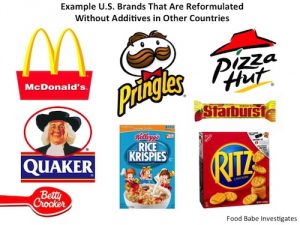
Thoughts of outrage, unfairness, disbelief, and ultimately grief consumed me while I was doing this investigation. A list of ingredients that are banned across the globe but still allowed for use here in the American food supply recently made news. While I have written about some of those ingredients before, this list inspired me to look a little deeper and find out how pervasive this issue is for us. Could these banned ingredients be contributing to the higher mortality and disease rates here in the U.S.? Why is there such a dichotomy between foods banned in Europe and around the world versus right here in the US?
The health of Americans is downright grim according to a report just released by theInstitute of Medicine and the National Research Council. It declares “Americans are sicker and die younger than other people in wealthy nations.” The United States spends 2.5 times more on health care than any other nation, however, when compared with 16 other nations we come in dead last in terms of health and life expectancy for men and near the bottom for women.
Here is the breakdown for you:
- More than two thirds of United States citizens are overweight – 33% being obese.
- 32% of children are either obese or overweight.
- 43% of Americans are projected to be obese in 10 years.
- After smoking, obesity is America’s biggest cause of premature death and is linked to 70% of heart disease and 80% of diabetes cases.
- And 41% of Americans are projected to get cancer in their lifetime!
Continue reading here>>
|
|
Start Your Day Right by Forgoing These GMO Breakfast Foods |
Breakfast is the most beneficial meal of the day, yet who knew that cereals are the latest to be added to the GMO Food blacklist. General Mills & Kellogg’s offer a not so fresh start of the day with a cereal bowl-full of GMOs. Throughout January 2013, GMO Inside called on consumers to make a Fresh Start with 4 Easy Steps, and to let Kellogg’s and General Mills know that we prefer our breakfasts GMO Free and with clear labels letting us know if products do contain GMOs.
Both Kellogg’s and General mills are icons in the breakfast food world, and while these companies claim to be healthy and wholesome, their products present a very strong argument to the contrary.
As part of GMO Inside’s call to action for a Fresh Start, we are focusing on cold cereals and snack bars, two common breakfast choices that carry a high risk of containing GMOs.
The following are breakfast cereals and bars from Kellogg’s and General Mills that deserve special acknowledgement for their intense use of controversial ingredients, a high risk of GMOs, negligible benefits as a breakfast food item, and additional transgressions in the GMO and health world.
Cold Cereal - While cereal by default is not the worst way to start your day, the following options are certainly lowering the bar for the whole category. These subsequent items stood out based on their particularly high use of likely GMOs, some clear nutritional no-no’s, and the inclusion of controversial ingredients beyond GMOs
Kellogg’s Honey Smacks Cereal:

The Honey Smacks ingredients list is a learning opportunity for those new to GMOs, presenting consumers with a solid list of ingredients that are either GMOs themselves or at a high risk of being derived from GMOs. Looking at the ingredients you see Sugar, Dextrose, Honey, Vegetable Oil, Caramel Color, Soy Lecithin, Vitamin C, and Vitamin B12 - all carrying their own risk of being a GMO. In fact, the only ingredients that are not on a possible GMO list are Wheat, Salt, the added Vitamins, and BHT.
Even if someone was trying to defend Honey Smacks as a breakfast choice, and they got you to ignore the fact that the vast majority of ingredients are probable GMOs, they would still have to address the fact that this cereal contains a considerable 15 grams of sugar per serving, very low fiber content for a breakfast cereal (good fiber content is something you should look for if you are looking for a healthier breakfast cereal), and that the ingredients list also includes hydrogenated oils and BHT, which have their own health controversies to deal with. In the end, this highly processed cereal is indefensible from a health standpoint.
Lucky Charms from General Mills:

It would not be a bad breakfast party without Lucky Charms, a strong contender for worst cold breakfast cereal by our research. Looking at the box, we start off on a high note in the ingredients list with whole grain oats , but it is all downhill from there, with a wave of possible GMOs including Sugar, Modified Corn Starch, regular old Corn Starch, Corn Syrup, Dextrose, Vitamin E , Vitamin C, Vitamin B12, and Artificial Colors. Lucky Charms is a highly processed product with 10 grams of sugar per serving, a full-range of controversial artificial food colorings, and strongly reliant on corn based products that carry a high GMO risk.
Fiber One, Raisin Bran Clusters from General Mills:

This option may surprise a few out there. While Fiber One may have some vaguely better breakfast options out there, these Raisin Bran Clusters standout for all of the wrong reasons. Possible GMOs include Corn Bran, Sugar, Corn Starch, Glycerin, Corn Syrup, Canola Oil, Molasses, Honey, Corn Meal, Malt Syrup, Natural and Artificial Flavors, Vitamin E. Vitamin C, and Vitamin B12. Also of note, controversial ingredient BHT is present, which has shown to be carcinogenic in some studies, and this cereal has more sugar per serving than Lucky Charms. One final thing to address is a fiber flaw. Earlier it was mentioned that a cereal being a good source of fiber is a good thing, well this cereal takes it way over the top, because 43% of your daily dietary fiber all in one serving is just unnecessary. It would be much healthier and comfortable for you to spread that amount of fiber across the first half of your day’s intake.
Breakfast Snack Bar - Bars are convenient and can sometimes look wholesome, but most pack quite a sugar punch and can be misleading with their dietary impacts due to their size. The following breakfast snack bars are noteworthy for their surprisingly high number of ingredients, the general lack of quality in those ingredients, and their intensive use of probable GMOs.
Kellogg’s Special K, Protein Snack Bar, Chocolate Peanut
This is one of the worst snack or meal bars that we came across in our GMO research this month. Looking at the nutrition facts of this protein snack bar, we see TBHQ, numerous sources of sugar, fully hydrogenated oils, controversial palm oil, and a trans fat asterisk hidden at the bottom of the ingredients list. The number of ingredients in this highly processed item is astounding, and the list of possible GMOs within that is a testament to this. Possible GMOs include Sugar, Whey, Soy Lecithin, Artificial Flavor, Corn Syrup, Fructose, Soy Protein Isolate, Cottonseed Oil, Rapeseed Oil, Toasted Soy Pieces, Soybean Oil, Soy Protein Concentrate, Glycerin, Molasses, Sodium Ascorbate, Soy Lecithin, Natural and Artificial Flavors, Vitamin E, and finally Vitamin B12. This bars nutritional panel is filled with red flags for the health conscious consumer.
Milk N Cereal Bars, Cinnamon Toast Crunch from General Mills

Probable GMOs on our nutrition facts label include Sugar, Malt Extract, Caramel Color, Maltodextrin, Dextrose, Canola Oil, Mono and Di Glycerides, Palm Kernel & Partially Hydrogenated Soybean Oils, Soy Lecithin, Natural and Artificial Flavors, Citric Acid, Corn Syrup, Soy Flour, High Fructose Corn Syrup, Fructose, Isolated Soy Protein, Glycerin, Sorbitol, Vitamin C, Caramel and Annatto Extract Color, Vitamin B12, and Mixed Tocopherols. It is disheartening how many possible GMOs there are in this breakfast bar, and while it presents itself as a good source of vitamins, the 14 Grams of sugar, the presence of BHT, TBHQ, the challenges of just reading some of these ingredients names, and the hydrogenated oils are more than enough to put this item on my do not eat list.
So there we have it, the cold cereal and snack bar products that stood out amongst a sea of other GMO heavy and unhealthy Kellogg’s and General Mills breakfast products.
If you think you have an even worse offender from Kellogg’s or General Mills, feel free to add it in the comments. But if you really want to make a difference… avoid these items, shop for non-GMO alternatives, and join us in a Fresh Start and let your voices be heard by the companies who do not want you to have the right to know what is in your food.
Remember breakfast is not dessert, and that it is possible to make choices that are healthy for yourself, your families, and the environment by rejecting GMO foods.
|